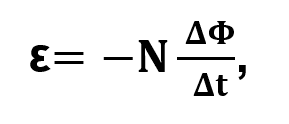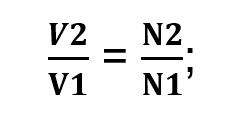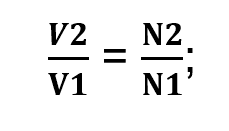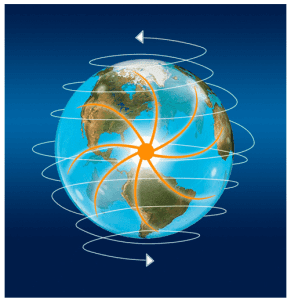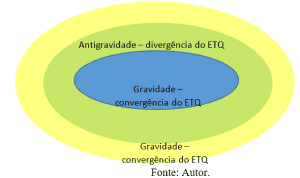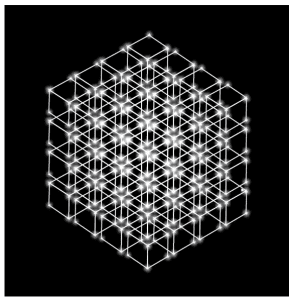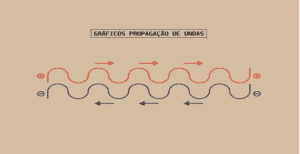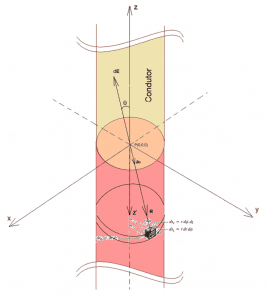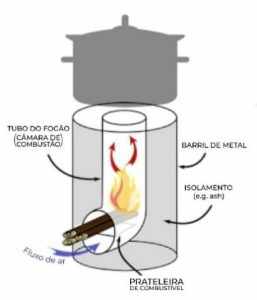ORIGINAL ARTICLE
FERREIRA, Ritiele Cássia de Almeida [1] , PAIVA, Edinei Canuto [2], DOURADO, Lara Fernanda Nunes [3]
FERREIRA, Ritiele Cássia de Almeida PAIVA, Edinei Canuto, DOURADO, Lara Fernanda Nunes. Electricity: from generation to distribution; Historical aspects and didactic proposal for teaching. Multidisciplinary Core scientific journal of knowledge. 04 year, Ed. 03, Vol. 04, pp. 51-102. March 2019. ISSN: 2448-0959.
SUMMARY
Physics is related to the basic needs of human beings, health, housing, food, transportation, among others. However, there has been a time since physics discipline presents one of the highest rates of failure in schools. This being perceived by many students as: very difficult, abstract, besides not relating to everyday life. However, this perception is attributed by several researchers to the traditional teaching method used by schools, which highlights with greater intensity the memorization of facts, formulas, symbols, theories and models without providing the student with the contextualization of Content, besides not worrying about exploring the contexts in which the laws and theories were proposed, thus generating the dogmatization of scientific knowledge. Therefore, this research aims to understand the development process from the beginnings of electricity to its practical application on a commercial scale, in order to produce a proposal of appropriate didactic-experimental material that can be Used in high school or higher education courses. To this end, a bibliographic review was developed in specialized literature, and the importance was verified in the approach of the teaching of physics, adopting the strategies of experimentation and the historical Study of science, elaborating finally a proposal of Didactic-experimental material related to the processes since the generation of electricity distribution, emphasizing its historical and social context, enabling it to promote debate, research, relating physical knowledge to life Thus facilitating the comprehension of the studied content.
Keywords: electricity, experimentation, teaching and learning physics.
1. INTRODUCTION
It has been diagnosed for many years the difficulties that exist in teaching physics. Among them we can highlight the disenchantment of the students in relation to the discipline, perceiving it as very difficult, abstract and without bonding with the daily life, thus causing high rates of disapproval. However, this conception is due to the traditional teaching model used by schools, which emphasize with greater vehemence the memorization of facts, formulas, symbols, theories and models that seem to have no relationship between themselves, besides not worrying about Explore the contexts in which the laws and theories were proposed, thus contributing to a dogmatization of scientific knowledge (Martins, 2006; Bonadiman, 2004).
Given this problem, proposals have been expressed that lead to the development of a teaching of physics, which contributes to the formation of a conscious, updated and participative citizen in the reality of the environment that lives. Thus, this work aims to understand the development process from the beginnings of electricity to its practical application on a commercial scale, in order to produce a proposal of appropriate didactic-experimental material that can be used in high school or in higher education courses. For this purpose, the following specific objectives were selected: Research in specialized literature, in order to identify the origins and the process of development of concepts related to electricity; Identify the importance of experimentation allied to the history of science as a strategy, enabling expressive and consistent knowledge in the teaching of physics; Build a model involving the processes from generation to distribution of electricity and elaborate a didactic material for the study of such an experiment.
2. THE BEGINNINGS OF STATIC ELECTRICITY
2.1 THE FIRST DISCOVERIES OF ELECTRICAL PHENOMENA
According to archaeology, man has been observing natural phenomena since prehistoric times, but it took a long time to record this set of occurrences and only later and that the search for rational explanations began. In the study of electricity, it was verified the existence of particular phenomena long before the old age, but only in this period is that these phenomena began to be researched and analyzed in the search for evidence that would explain the occurrence of these.
According to Luz and Álvares (2000), the first electrical phenomena were observed by the Greeks in antiquity. The mathematician and philosopher Thales de Mileto in the SIXTH century A. C. Was the one who observed that a piece of amber, a fossil resin, after being atried with an animal skin, would acquire the property of attracting light bodies. By observing this phenomenon, Thales in an attempt to explain it through philosophical thought, attributed to the substances capable of electrification having a soul, and this in turn attracted the pieces of inanimate matter. It is verified that the first attempt to explain the electrification by friction is very old, however the phenomena related to electricity have been forgotten for several years due to lack of practical application.
Only about 2000 years later several scholars began to make more systematic observations about electrical phenomena. In this context it can be highlighted: the English physician William Gilbert, who resumed the observations of Thales found that it was not only the amber that possessed the property of attracting bodies, whether they be light or not. This finding was obtained through a very sensitive apparatus, built by Gilbert called Versorium, using this apparatus he can check the existence of electrical forces of other objects such as diamond, Sapphire, opal, amethyst, crystal between Others, as described in his work of Magnete. To explain this attraction, Gilbert used the hypothesis of Effluvius, an interesting fact is that although Gilbert’s experiments were carried out very carefully and several times, he did not observe the repulsion of the electrified bodies, this was only observed by the German physicist Otto von Guericke, when he reproduced Gilbert’s experiments. This fact allowed him to observe that when the bodies are electrified by friction, they can attract or repel other bodies. In order to better observe this phenomenon Guericke built an apparatus consisting of a large sphere of sulfur that could be moved by a crank, this being the first electrostatic machine to be built; With this he can also perceive that “electricity” could move from one body to another through contact, however he did not seek explanations for this phenomenon, because he believed that this behavior was natural, due to the virtues existing in the body. (TORRES, FERRARO and SOARES, 2010).
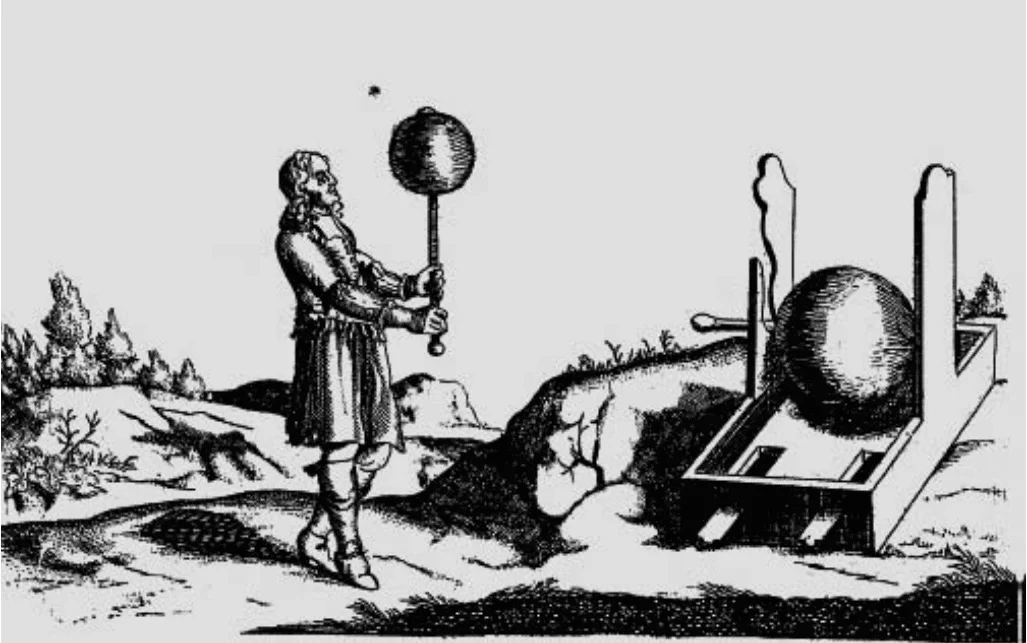
As described in the course of this subchapter, over the years there have been several discoveries related to electrical phenomena, however no explanation has been formulated for these phenomena. Only from the discovery of the conductive and insulating materials that this happened.
2.2 THE FIRST EXPLANATIONS OF ELECTRICAL PHENOMENA
With the continuity of studies related to electrical phenomena, Gaspar (2003) recalls the discovery made by Stephen Gray in 1730 on the conductivity of materials. He realized by rubbing a closed glass tube with two cork stoppers, which both had the ability to attract small feathers. Continuing his experiments he adapts to the cork using the string other materials such as a small wooden trunk with an ivory ball on the tip, metal filaments or twine, and found that they all attract the small lightweight bodies that were Placed in its proximity, but he noticed that if it was used to make this connection a metallic wire the phenomenon of attraction was not verified. In this way he classified the materials by styling those who better lead the electricity of conductors, unlike others who did not conduct, or mislead the electricity, giving them the name of insulators. These observations served as a basis for the emergence of the idea that electricity was a fluid that could move from one body to another (SILVA and PIMENTEL, 2008). In this context, it is worth mentioning the proposals of Charles Dufay who played an important role in explaining the phenomenon of attraction and repulsion, when he performed several experiments found that there were two behaviors for the materials, some behaved like glass, and others like the resin, thus proposing two types of electricity: a glasselectricity and a resinous electricity. Whittaker cites Dufay’s perceptions of the phenomenon of attraction and repulsion:
[…] That there are two electricities of a totally different nature namely, that of transparent solids, such as glass, Crystal, & C., and that of bituminous or resinous bodies, such as Amber, copal, sealing-wax, & C. Each of them repels bodies which have contracted an electricity of the same nature as its own and attracts those whose electricity is of the contrary nature. We see even that bodies which are not themselves electrics can acquire either of these electricities and that then their effects are similar to those of the bodies which have communicated it to them (1973, p. 40).
This fact launched the idea of the vitreous fluid and the resinous fluid, so the electricity contained in a body was the one that possessed it in excess, and this new hypothesis gained great acceptance throughout the EIGHTEENTH century.
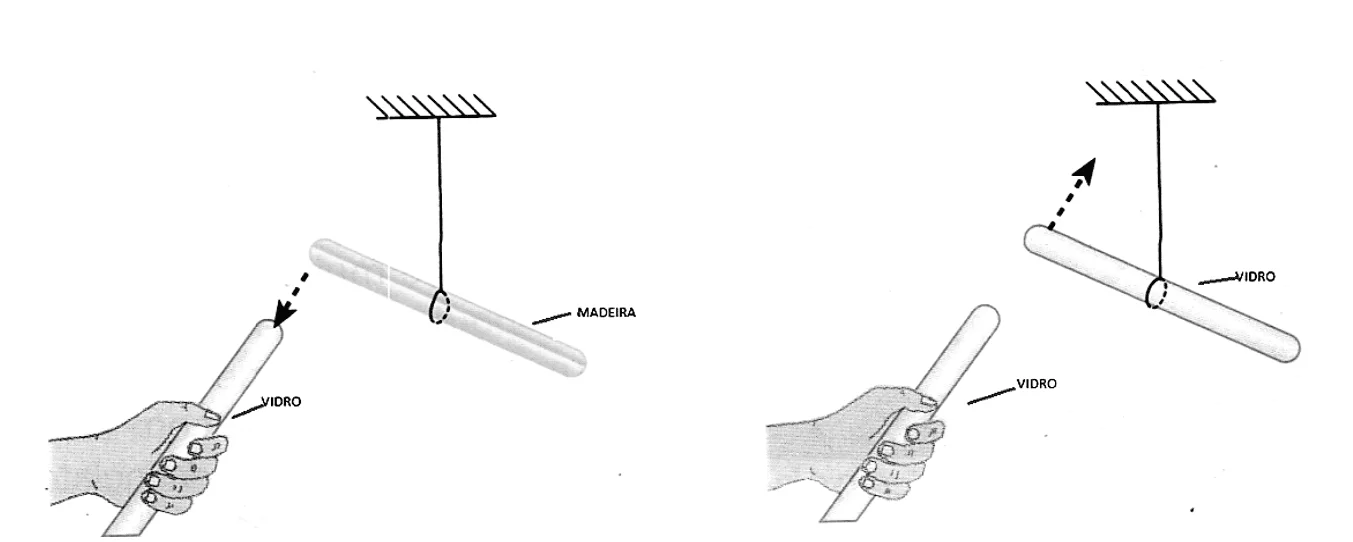
. Source: TORRES, FERRARO E SOARES, 2010, p. 14.
According to Silva and Pimentel (2008), Dufay’s studies were continued by the Frenchman Jean-Antoine Nollet. He created several experiments to exhibit and demonstrate the electrical effects, proposing with these new explanations for the observed phenomena, and such elucidations were accepted in all countries of Europe. To clarify the electrical phenomena Nollet, used the idea of the movement, in which the two currents of electric fluid, would move in opposite directions. According to Nollet, when we hit a body, its fluid escapes causing an effluent current, this loss, but is restored by a tributary current of the same fluid coming from outside. This system predominated for some time, however when Benjamin Franklin presents in his book an entirely different explanation, about the electrical phenomena Nollet’s ideas are abandoned, and currently he is not even remembered.
Luz and Álvares (2000) and Gaspar (2003) affirm that in the course of the EIGHTEENTH century, Europe lived a time when rich society, did not care for religious principles, and sought good looks and fun. In this context the electrical phenomena were very successful, one of the phenomena that became fashionable were the shock and the electric kiss, so several people performed several shows even in public squares. Benjamin Franklin Observing one of these spectacles was interested in the electrical phenomena and from then on began his studies, developing the concept of unique fluid. This idea of Franklin’s unique fluid was based on the proposal that the bodies were formed by the common matter and the electrical matter, and it was this electrical matter, also called electric Fire that made the body able to attract or repel other bodies. So, Franklin explained that when we have a body to the other, electrification is due to the accumulation of fluid by one of the bodies, while the other would lose that fluid. Having established that the body that received the fluid was called positive and what lost negative.
It is therefore worth noting that Franklin’s unique fluid theory is partially correct in relation to current ideas about the process of friction electrification. Currently we know that in fact there is a transfer of electrical charges between the bodies, however this exchange of loads is affected by the passage of electrons from one body to another and not due to the exchange of fluids as stated Franklin. However, it was only possible to correctly explain the electrification process, in the early TWENTIETH century, after the discovery of the electrons.
Therefore, with the evolution of the atomic model, we know today that the electrons found in the electronic layers farther away from the nucleus can move from one body to another. So, we can explain the various electrification processes.
3. THE DEVELOPMENT OF ELECTRICITY DURING THE EIGHTEENTH CENTURY
According to Tolentino and Rocha-Filho (2000) and still Germano, Lima e Silva (2012) During the EIGHTEENTH century, studies related to electricity became more systematic, and for this several experimental apparatus were built, among them we can Highlight the electrostatic machines built based on the Von Guericke machine. However, there was no continuous flow, because the electrical charges generated by these machines only produced intense sparks, or could flow through metallic ends, and still be stored by the Leyden bottles known today for Capacitors.
In the early days of electricity there were no apparatus that allowed the storage of electricity for a long period. By the year 1800 the only means of producing an electric current was through the discharge of the Leyden bottle through a conductor. The first evidence of the Leyden bottle dates from 1745, when according to Rocha (2011), clergyman E. G. von Kleist and professor at the University of Leyden Pieter Van Musschenbroek, produced almost concomitantly such a device in the attempt to Find a way to reduce the load loss. In this context it is noteworthy that the idea that the bodies loaded, when exposed to air, lost their electrical charge by means of the evaporation of the electric fluid. Based on these ideas, the scholars carried out the following experiment: they Tamparam with a stopper a glass bottle, filled with water, then sticking a nail through the lid, which came in contact with the water, then holding the bottle with one hand, Electrified the nail using a electrostatic machine; After such procedure placed the bottle under a non-insulating surface, and when touching the nail received a great shock. After the success of such an experiment, this was disclosed and many people tried unsuccessfully to reproduce this procedure, because according to reports when carrying the bottle, they left it isolated. In the course of the time to the bottle was being improved, but this apparatus produced only a transient current.
However only after the discoveries of Luigi Galvani and subsequently the creation of the first cell by Alessandro Volta became possible to explain in detail the electrical phenomena observed.
With the publication of the monograph of Galvani, the new phenomenon observed has a wide dissemination mainly in the research centers of Europe. In this context, the professor of physics at the University of Pávia Alessandro Giuseppe Anastásio Volta, in knowing the experience of Galvani decided to reproduce it, as well as all the experimenters of the time. In repeating the experience, Alessandro Volta agreed at first with Galvani, believing that animals produced electricity. However, by deepening their studies in the area, further investigating the experiment, Volta proposes a new explanation for the phenomenon observed (TOLENTINO and ROCHA-FILHO, 2000).
According to Martins (1999), Alessandro Volta in repeating several times making some alterations in the Galvani experiment, found that the contact was not necessary exactly with the frog muscle, because the contractions occurred also when different points of Thigh nerves were connected by means of a bimetal arch. By directing their attention to the importance of using different metals in the verification of such a phenomenon, Volta observes that when a bimetal arch is used in the circuit, the contractions are stronger than those with Monometallic arch. This serves as the basis for Volta propose that metals play not the role of conductor of animal electricity, but that electricity comes from an external origin, resulting from the difference of the metals that form the arc, so are the metals that produce such an effect. And the frog, however, would work as a very sensitive detector of electricity, reacting to both this metallic electricity and any form of electricity. However, in this period there is an important observation made by the physicist Johann Georg Sulzer. He put his tongue between two silver discs and lead realized that in contact with the edges of the discs, felt an uncomfortable taste. Returning to the knowledge of such experience, reproduced it, after making alterations including its eyeball, it can observe that when the electrical contact was established, a sense of light was perceived. Such facts served to reinforce the hypotheses of back that it was not necessary to contact with the muscles, for the occurrence of contractions, and that the metals were the electricity generators themselves. However, these ideas faced major problems, because the experiments that led back to discovering such electricity (produced by contact between different metals), used animals, so they could be interpreted as originating from Animal electricity.
Thus, arises a controversy between Volta and Galvani, the latter did not accept the interpretation of Volta, because it had shown that contractions occurred, when established the contact between the nerve and the muscle using equal metals. Going beyond, Galvani shows around 1794, that it was not necessary to employ any metal to achieve electricity, such hypothesis departed from the observation of the occurrence of contractions by placing the sectioned crural nerve of a dissected frog in contact with the muscle of Leg. Such experience, which would prove animal electricity, was not accepted by Volta, for in this case the contractions of the frogs ‘ legs occurred due to a mechanical stimulation. And so, he proceeds, in an attempt to discover evidence that proves his hypotheses (MARTINS, 2000; TOLENTINO and ROCHA-FILHO, 2000).
According to the clarification of Martins (1999), Volta attempted to detect the electricity generated by different metals by means of an electroscope, but not succeeding and assuming that the electrical voltage generated was too weak to be detected by such instrument, it builds a sensitive apparatus: the electrolyte. Using such apparatus, in 1796, Volta can detect weak electrical voltages generated by different conductors. But that was not enough, because at the time he wanted to prove that his ideas were well founded, and for this he seeks to produce using metallic pairs, strong electrical effects; As a result of this research is born to the stack.
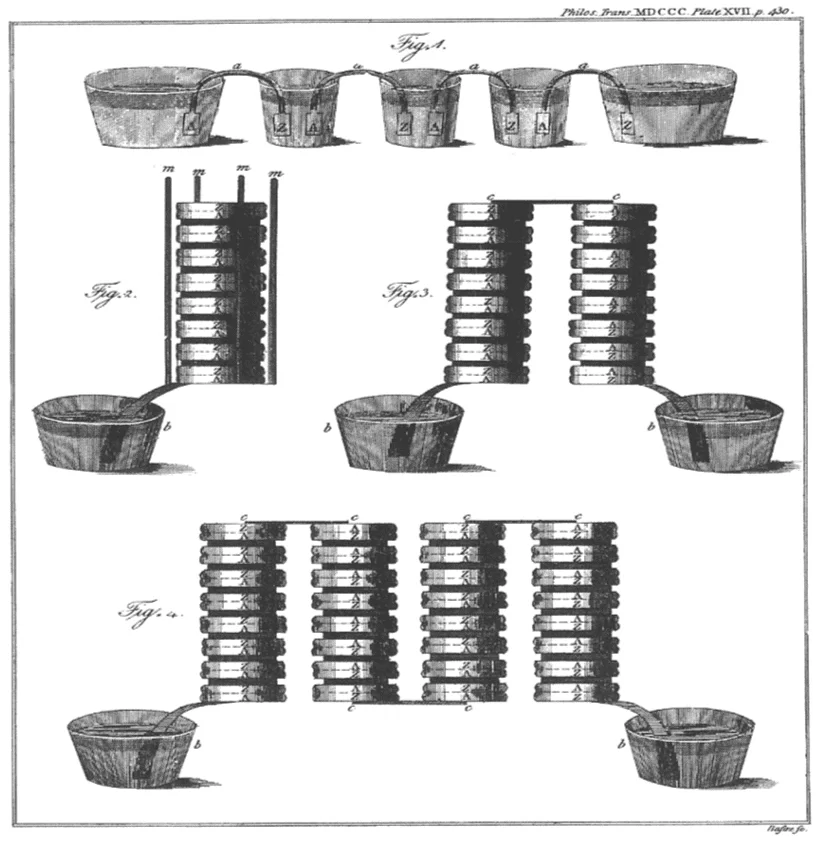
As the letter of return sent to the Royal Society, for the construction of his device, he stacked silver and zinc discs, separated by cardboard soaked in saline solution. Back suggests that other metals could also be used, such as: tin, lead and copper, but the best combination was silver and zinc. This device was built so that the lower discs were silver and the upper zinc discs, having the terminals of these wires connected to lead the electricity. In addition to the pile, Volta tested an arrangement, placing side by side containers of glass, wood or ceramics, filled to half with a solution of salt or with a barrela, so that such containers were connected by a set of blades, whose terminals were a silver , deposited on copper, and the other of zinc (or tin), immersed in the next canister. In the letter back, he discusses only the physiological effects, because they called more attention in that period. However, with the battery it was possible to study the behavior of the electric current and its effects, in addition to verifying the decomposition of the substances (CHAGAS, 2000; MAGNAGHI and ASSIS, 2008).
4. THE ADVANCES IN ELECTRICITY IN THE NINETEENTH CENTURY
4.1 BRIEF INTRODUCTION TO THE HISTORY OF ELECTROMAGNETISM
Throughout the NINETEENTH century, with the discovery of the pile by Alessandro Volta all the production of electricity proceeded from electrochemical reactions, being this great one of the fundamental parts for the discovery that was the landmark of this century: the laws of electromagnetism.
According to Rocha (2011) until the beginning of the NINETEENTH century, electricity and magnetism developed without any bonds, and were considered distinct fields. However, in the first two decades of this century, the experimental works that sought to prove the relationship between electrical, thermal, magnetic, chemical and optical phenomena developed considerably. In this context we can highlight the work of one of the scientists who defended the existing relationship between magnetism and electricity: Hans Christian Oersted, whose discovery results in the unification of these fields, giving rise to the branch of physics, called Electromagnetism.
Based on the knowledge that the passage of electric current on a wire, provoked the emission of light and heating, the scientist Oersted deepens his studies conducting experiments, in order to confirm his hypotheses. As Alvares and Luz clarifies this rigorous work, succeeded in 1820, when Oersted, when assembling an electrical circuit with a magnetic needle, realized that:
With no current in the circuit, the magnetic needle was oriented in the north-south direc[…]tion, by establishing a current in the circuit, Oersted observed that the magnetic needle deviated[…], interrupting the current, the needle returned to its initial position, along the North-South direction (LUZ and ALVARES, 2000, p. 210).
This phenomenon observed by Oersted, provoked a great leap in scientific society, motivating several scientists from Europe to investigate the causes of such an event. According to Oersted’s vision, this fact was due to the movement in the opposite direction of the electric current, which was composed of two flows of loads (positive and negative), inside the wires. The consecutive meeting and separation of these charges generated the electrical conflict. Assuming that this electrical conflict did not restrict to the inside of the wires, being also existing in the environment around the wire; Oersted, explains that the deflection on the wire is due to the interaction between the electrical conflict of the exterior of this with the magnetic poles of the magnet. However, his theory had few adherents; Only their experimental results were slightly accepted by the scientific community (CHAIB and ASSIS, 2009).
One of the scholars of this century who also deserves prominence is the Frenchman André-Marie Ampère. In his work he devoted himself to chemistry and mathematics, showing no interest in electrical and magnetic phenomena until he became aware of 1820 of Oersted’s experience while attending Arago’s performances at the Academie des Sciences in Paris. However, Ampère in seeing such a presentation, notes that the works of Oersted would be incomplete, initiating a research in an attempt to elucitake the nature of the phenomenon. By reproducing the needle imantation experiment, it suggests a new vision defending the principle of action and reaction between the wire and the magnet. Thus, he explains that the phenomena observed in Oersted’s experience, occur due to the existence of electrical currents inside the needle. However, to defend this proposal, Ampere had to demonstrate employing only electrical circuits, the ability to reproduce the effects of one magnet on another and also of a closed circuit on a magnet. These experiments were published in two parts in volume 15 of the Annales de Chimie et de Physique de 1820 (GUERRA, REIS and BRAGA, 2004).
According to Dias and Martins (2004), another formidable contribution to electromagnetism was the discovery of Michael Faraday in 1831 of electromagnetic induction. It is known that in the laboratory of Humphry, where Faraday began his scientific career playing the role of Auxiliary, he met vastly the world of science, thus making a great experimenter, which was extremely useful for the development of Their work related to electromagnetism. His interest in this field began in 1821, when the editor of the Annals of Philosophy, Richards Phillips invited him to write a review article about electromagnetism. To perform this function he remade several experiments, in addition to studying several theories, thus proposing new experiments.
When investigating the magnetic force, coming from a conductive thread, using an imanthated needle, Faraday noticed that instead of the poles of the needle suffering an attraction and a repulsion, they tended to rotate around the wire. From this observation he devoted notably to this subject, leading him to publish an article, where he presented experiments that allowed verifying the rotation of a conductor wire around a magnet and also the opposite movement. With the publication of this article a communication was established through letters with Ampère, as a result of this contact Faraday met the book: Manuel d’electricité dynamique, written by Demonferrand, where he ensured that an electric current passing By a conductor could induce a constant current in another placed in the vicinity. This fact interested him a lot, thus initiating the studies of Faraday related to the phenomenon of induction, and thus he builds several experiments in the search for experimental evidences that explain this phenomenon. As described in their journals, after years of trying the first successful experiment, it was concreted on August 29, 1831. To accomplish such work, he built a sweet iron ring, containing several copper wire turns wrapped around it, this being separated by two sides: A and B. Thus, the following procedure was performed:
The two windings on side B were joined together to form a single one, and its end was connected to a copper wire passing over a magnetic needle[…]. Thus, the needle when moving would indicate the passage of a current by the B side of the ring. One of the turns of the A side was connected with a battery an[…]d, with the passage of the current from side A, coming from the battery, a current was detected on the B side of the ring (DIAS and MARTINS, 2004, p. 525).
Thus, it was possible to visualize the magnetization of the needle. However, the effect found in this experiment was not from a magnet over a current, but from an electrical current over another. After several reflections on the result of his experiment, Faraday continues his studies, and when testing a new experiment in which he is using an iron cylinder and the L helix, proceeded as follows:
All the wires were joined in a single propeller and connected to the indicator propeller, at a distance, by the copper wire, then the iron was placed between the poles of the magnetic ba[…]r. Every time the magnetic contact in the North or south was established or broken, there was magnetic movement in the indicator propeller. […] But if the electrical contact (i.e. through the copper wire) was broken, then the Breakers and contacts did not produce any effect (FARADAY, apud DIAS and MARTINS, 2004, p. 527).
Therefore, it finally obtains an electrical current induced by the action of a magnet and thus and observed the phenomenon of induction for the first time. It is important to emphasize that due to the aggregation of electricity, with magnetism, generating a new branch in science, and consequently with the discoveries of induction laws, new possibilities and major innovations emerge for the industries, opening the doors to the Investment in the production of electricity on a larger scale.
4.2 THE BEGINNINGS OF ELECTRICAL MACHINES
The construction of electric motors was the first step towards the technological innovations that existed today, which were not even dreamed in the early NINETEENTH century. With the use of electric motors, it has become possible to revolutionize the industry, thus allowing a world of facilities. However, for the consolidation of such an instrument, several researchers were involved in such activity, and much had to be developed, improved and tried until we arrived at the engines capable of generating enough electricity for their use in the industry.
According to Pomilio (2012), the first DC motors (working with current continues), were built approximately in 1831, by Faraday. It built a generator, consisting of a copper disc of approximately 30 cm in diameter. It is important to highlight in this context the invention of the English Willian Sturgeon, which in 1825 verified that when an electric current was applied to a conductive wire, which involved an iron core, it was transformed into a magnet, having its strength interrupted when the Current was suspended, thus was invented a very important part in the construction of rotating electric machines: the electromagnet.
Continuing the process of machinery construction, it is worth highlighting the invention around 1833 by the switch scientist W. Ritchie, ask this important in the electric motors. The switch is a key piece in the DC motors, as they have the function of periodically exchanging the direction of the current on the rotor in such a way as to ensure that the torque always has the same direction, thus preventing the rotor from being stopped in a position of and Equilibrium (ALVES, 2003). Later around 1837 the work of Thomas Davenport and his wife Emily resulted in the patent of an already improved CC engine. But besides these rudimentary engines have a very low yield, there was not enough power to supply such devices. However, it appears in 1873 1 means of minimizing the problem of energy waste, thanks to the discovery of the reversible dynamo by the Belgian scientist Zenobe Grame. He was one of the important collaborators in the development of electric machines, the dynamo being the result of his work inspired by the machine of Antônio Pacinotti. As quoted by Souza et al (2010), the original equipment consisted of:
[…] A massive iron ring with vertical rotation axis around which were wrapped 16 electric coils regularly spaced by wooden wedges[…]. The coils were connected in series and each connection between two of these coils was connected to a blade of a stress collector, located at the base of the vertical rotating axis of the ring. This circular structure is commonly known as Pacinotti’s “armor” or “Ring” (p. 5).
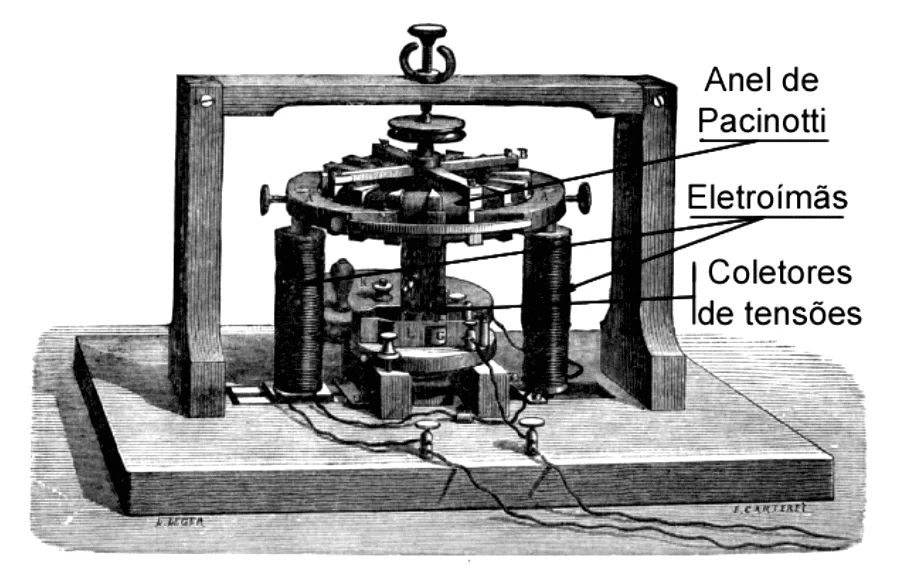
rce: Souza et al, 2010, p. 5.
Making an adaptation to the machine, Zenobe Grame replaced the solid iron core, by a laminated ring consisting of beams of iron wires, being isolated from each other. He also added 16 coils in the ring, resulting in 32 coils. This adequacy had the objective of decreasing the induced currents in the nucleus, and limiting the pulse of the generated tension that comes out of the machine, contributing to the increase of the magnetic field on the coils, thus generating a better performance of the machine, because in this way There would be no major losses in the process of energy generation and transformation. Thus, it was developed around 1869, the equipment known at the time as ring of Grame. An important event that we want to highlight occurred in 1873 in the Vienna exhibition was to discover the reversibility of Dynamo. When Grame connected two direct current dynamos in parallel, with only one of these machines, the drive device, it was perceived that one of them began to rotate, thus applying a torque on its axis, acting as a motor (SOUZA et al, 2010; POMILIO, 2012).
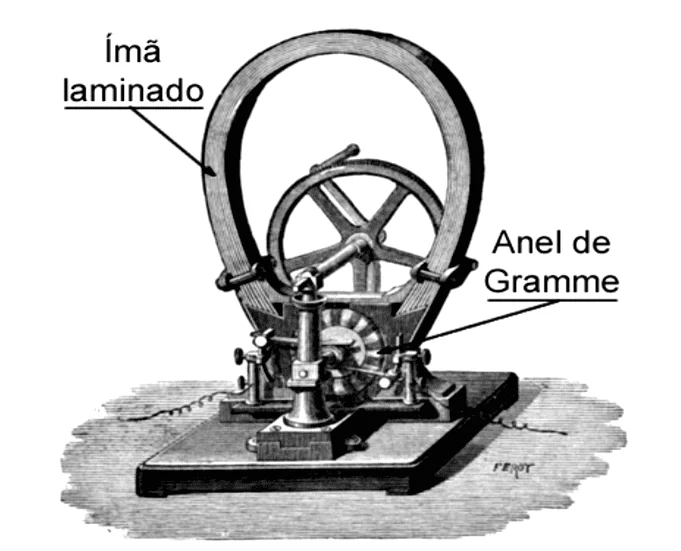
machine: Souza et al., 2010, p. 8.
However, the Grame machines were instrumental in unraveling the process of production of scientific knowledge of the NINETEENTH century in the field of electricity, thus it became possible to generate electric power in quantity needed to meet the demand Existing in the industries.
4.3 THE USE OF ELECTRICITY FOR COMMERCIAL PURPOSES-THE CLASH BETWEEN THOMAS EDISON AND NIKOLA TESLA
Around the beginning of the NINETEENTH century, the gas lighting system begins to emerge, replacing the candles and oil lamps. Soon afterwards arises the idea of the use of electricity in lighting, developing in this way the arc lamp, but such instruments besides not being economical were extremely bright to be used at home; And it is soon perceived that the use of filament in the lamps would be the best alternative for obtaining the desired luminosity. Therefore, researchers start their work in order to find the appropriate material to be used in the filament. In this context we can highlight the inventor Thomas Alva Edison, who develops his works by inventing the high vacuum lamp, with carbonized bamboo filament. From there he invests in the expansion and utilization of electricity, creating his electric power company, supplying power in current continues.
The important inventor and entrepreneur Thomas Edison who greatly excelled in the NINETEENTH century, contributing to the advent of the power generation and distribution system, was born in a middle-class family on February 11, 1847 in the city of Milan Ohio, USA. His school life was short, because he had problems at school and according to his teacher, he was very questioning and restless. So, he leaves school very early, getting his mother who was the teacher responsible for her education, arousing her interest in science. Since early Thomas begins to work to get money to carry out his experiments. And at the age of 21, he has recorded his first invention: the voting machine; However, it does not achieve the expected recognition. Seeking to become an independent inventor, reaching New Horizons he moves to New York. After going through a very difficult time, he has his contract signed to the Western Union Company when he sells to her his invention of the automatic indicator of stock Exchange quotes. Around 1876, five years after his hiring was already a famous inventor, and the breadth of his activities propels the construction of the Great Research Center Menlo Park. In this environment consisting of laboratories and workshops, surrounded by trained assistants and technicians, Edison proposes to produce every ten days a new invention, but failed to achieve such a goal, but it is true that in a period of four years managed to patent 300 inventions, among them we can highlight the phonograph, the coal microphone, Cinetograph (film Machine), Vitascope (screen film projector), electricity counter, Ditafone, kinetoscope (box with images filmed seen inside), Incandescent lamp, the creation of an electric power plant among others, which together modified the world, definitively consecrating the technology (CORRÊA, 2011).
In the year 1882 the Edison Eletric Light Company belonging to Thomas Edison, develops the world’s first electric power plant for commercial purposes, located on Pearl Street Street in New York. The power plant that supplied current electricity continues to about 59 customers, had several steam generators and for operating in single voltage, they should be 800 meters away from the points of consumption. But the success of Edison is soon threatened by the imposing arrival of the proposals of the use of alternating current, by his rival Nikola Tesla who intended to exceed the limitations of the current continues (LAMARÃO, 2012; CORRÊA, 2011).
According to FUKE (2010), the great supporter of alternating current, the Serbo-Croatian Nikola Tesla born on July 10, 1856, since the age of 19 progresses in electrical engineering studies when he enters the Polytechnic School of Graz, Austria, there he knows a field of research that much intrigues you: electricity; And from this moment he yearn to understand his laws. His professional career starts around 1881, when he becomes an electrical engineer at the National Telephone Company in Budapest. Around 1882 he goes to work at the Continental Edison Company in Paris, improving electrical equipment. It is important to emphasize that it is in this period that he idealizes the instrument in which he believed it was possible to generate alternating current, which until then was considered impossible by scientists, this is the induction motor. Aiming to broaden his knowledge of electric current, he leaves in the year 1884 to the United States where he begins to work in the company of Thomas Edison, where after gaining the respect of the entrepreneur, he was attributed to the function of perfecting the dynamos of Current continues in order to achieve an improvement in efficiency. If such a goal were successfully accomplished, he would be rewarded with 50000 dollars. Thus, Tesla strives for one year in the improvement of such instruments, achieving a profitable efficiency for the company of Edison; But did not receive his prize as agreed, leading him to resign (WHITE, 2003).
Meanwhile, while developing his remarkable work at Edison General Eletric, Tesla became famous in specialized circles. And so, after his resignation he founded around 1886 in his company: The Tesla Electric Light and Manufacturing Company. However, their financial investors did not support their ideas of developing the AC motor, since again it is led to let the job become frustrated again. But after many fights, Tesla’s ideas are welcomed by also engineer George Westinghouse, owner of the Westinghouse Electric Company, which finances the development of his devices and soon buys his patent. It should be clarified that until this period predominated the current remains disclosed and distributed by Edison, but the works of Tesla enabled to generate and distribute electricity in alternating current, in order to overcome the limitations of its competitor (HARF, 2010).
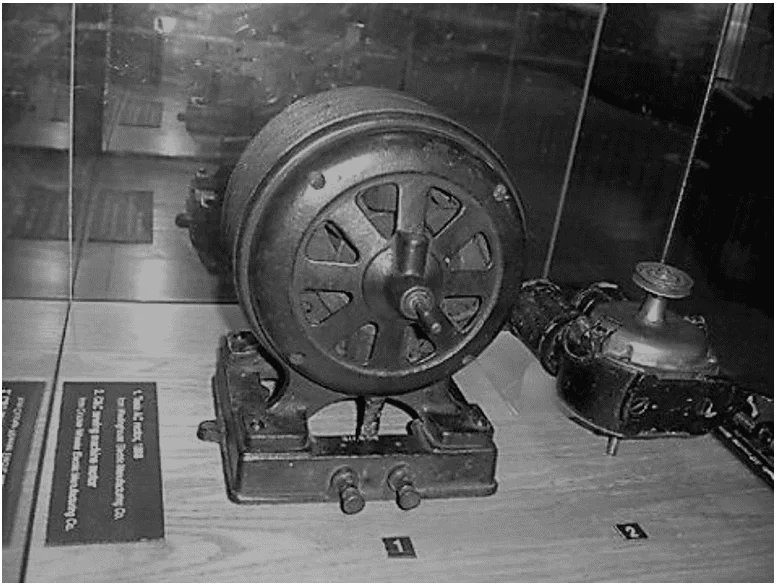
Source: Available at www.teslasociety.com.
In this way comes the known battle of the currents, where two ideas disputed their space. On the other hand, the current continued, which until now met the demands of society, on the other hand the alternating current was more easily both in the generation and in the transmission of energy, overcoming the difficulties of its competitor in raising the Work voltage and be transmitted to long distances until reaching the consumer. However, Tesla’s ideas had more advantages, thus gaining preference; But Edison not satisfied strives to discourage the use of alternating current, for this in his campaign he arrives to execute animals by means of electrocution, in order to show the risks existing in the transmission of alternating current, which according to it did not occur With the current continues. However such appeals did not achieve the desired result, as it was to the Westinghouse company using the ideas of Tesla, the one chosen for the great energy generation project that consisted of Riging the Niagara falls in order to produce electricity, Generating enough energy to supply the Bufallo industry in new York City, marking a new era of electricity. In view of this, Nikola Tesla wins such a dispute, and from there the alternating current was legitimated as a way to produce and distribute energy (GUIMARÃES, 2010).
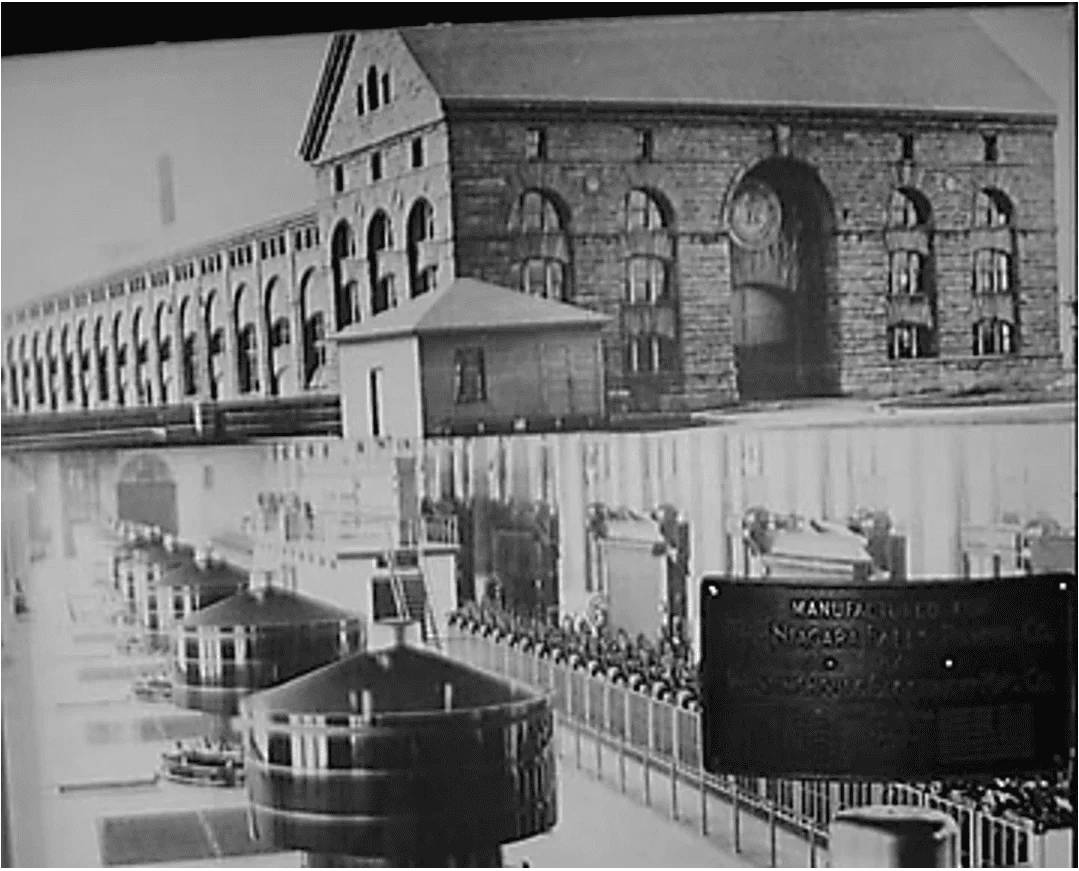
5. ELECTRICITY: THE PATH TRAVELED FROM GENERATION TO CONSUMPTION
Electricity has become indispensable for the survival of the human being, being used for the purposes from domestic to industrial. Currently, thanks to technological development, there is a diversity of electronic equipment in the residences, industries, hospitals, among other places that presupposes in the supply of electricity for its operation; In this way, electricity is essential for technological progress. However, it is not a primary energy, that is, for its production it is necessary to use a primary energy source, such as coal, petroleum, natural gas, uranium, sugarcane product, sea and river waters, Wind, Sun, among others.
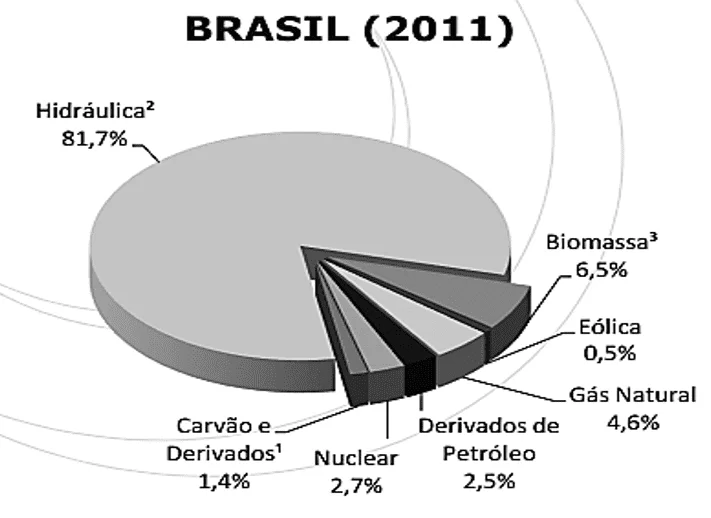
ource: BRASIL, 2012, p. 31.
According to the energy research company, the National Energy Balance (BNE) points out that in 2011, 81.7% of the electricity produced in Brazil comes from hydroelectric power plants, this being the largest source of contribution.
Usually the primary sources are distant from the consuming population, and it is necessary to invest in the transmission of energy. In this way the Brazilian electrical system is constituted of the generation, transmission and distribution of energy.
In the generation, large power plants produce the electricity that is then transmitted to the power substation, which normally raises the voltage and sends it to the high-voltage transmission systems. It is then forwarded to substation near the consumption center that generates the average and low voltage, and then, through the distribution lines, are transformed to appropriate voltages to be delivered to the final consumer through the service line (Ferreira et al, 2010, p. 20).
5.1 THE GENERATION OF ELECTRICITY IN BRAZIL
According to the graph presented in Figure 13, we have that the electrical matrix in Brazil consists in the use of renewable and non-renewable sources for electricity generation. In this way it is important to clarify how these sources are used in hydroelectric, thermoelectric, nuclear and wind power plants for energy generation.
Currently, the power of water is used in hydroelectric power plants for the generation of electricity. These in turn are basically formed by: Reservoir, dam, spillage and power house. The reservoir arises when the water is dammed with the creation of a dam, this in turn is built to accumulate water. The spillway has the function of controlling the water level of the reservoir, especially in the rainy season, because it allows the water to flow directly into the leakage channel without needing to pass through the Power house. Finally, the Power house is the place where the power plant operates, and the turbine-generator and auxiliary groups are located.
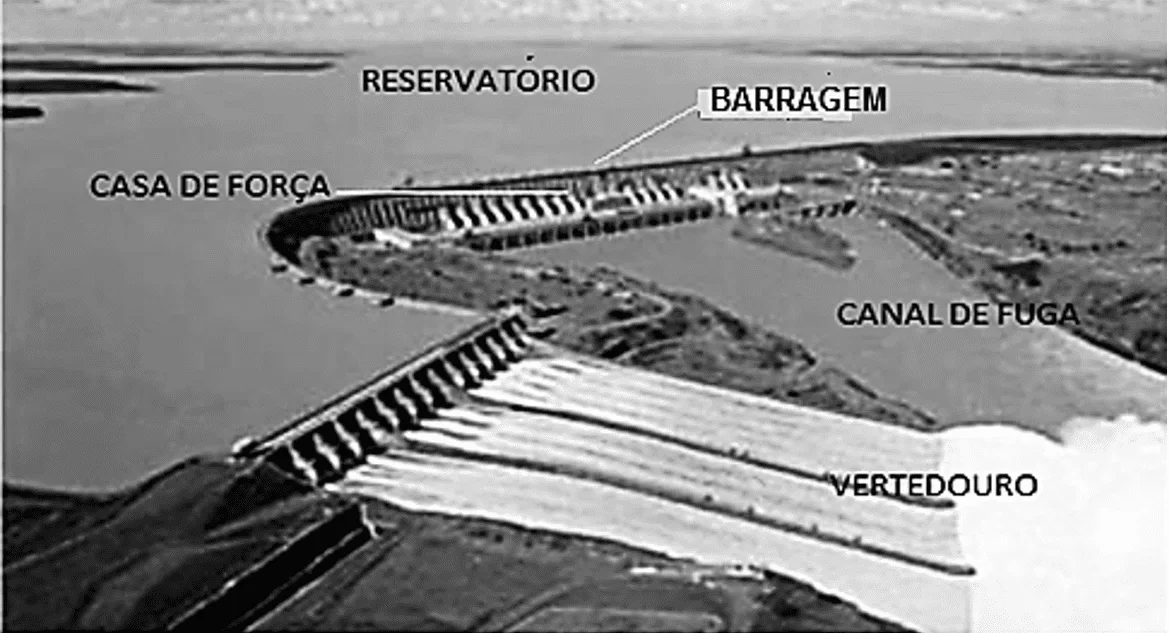
Source: Adapted from www.portalsaofrancisco.com.br
In hydroelectric power plants, electricity is acquired by energy transformation. Basically, its operation consists in the transformation of the potential energy existing between the reservoir level and the river after the dam, in kinetic energy when the water coming out of the reservoir is conducted by means of pipelines, being incided in the blades of Turbines making them rotate. This turbine is connected to a generator, which consequently enters into motion, transforming the kinetic energy into electrical energy, after this process of generating the energy is transmitted to the elevating substations, where the voltage supplied by the generators Is high by means of Transformers (MOTA, 2010).
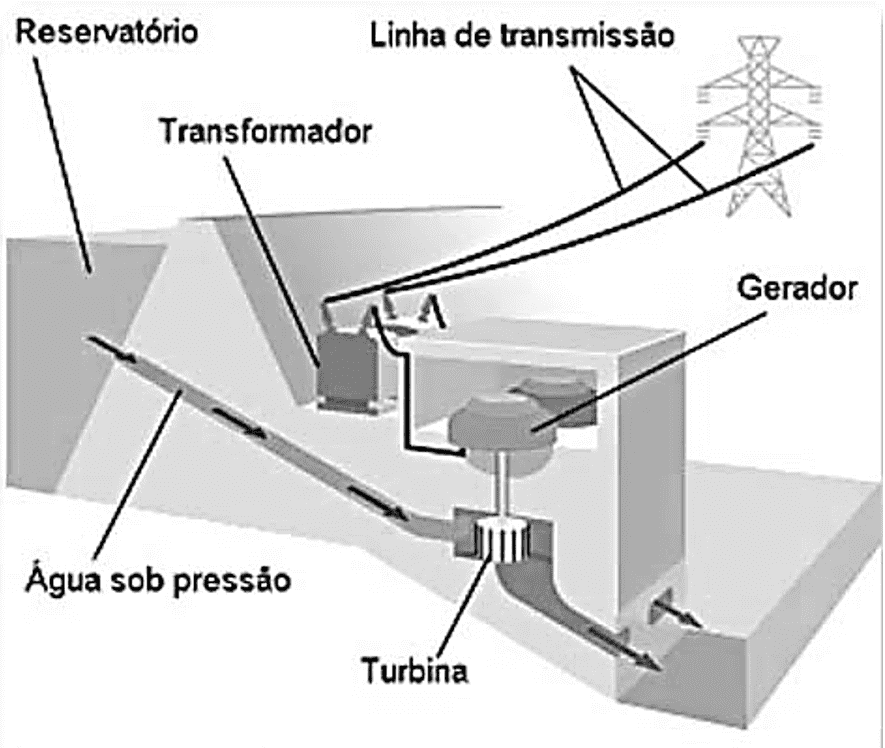
Source: www.portalsaofrancisco.com.br
While in the thermoelectric plants the movement of the generator is obtained by combustion of fossil fuels such as coal, oil derived from petroleum or natural gas, or from renewable fuel such as sugarcane bagasse, leaves, twigs, leftover crops firewood, charcoal Mineral and even organic waste. Independent of the fuel thermoelectric plants have similar operation, which consists of the following process: During the burning of the fuel in the boiler, it generates steam from the water circulating through an extensive network of pipes that cover its walls. This steam is used to move the blades of a turbine whose rotor rotates together with the axis of a generator, thus effecting the transformation of the thermal energy into kinetic energy and soon after in electrical energy. In this generation system, after the incidence of steam in the turbines it is cooled in a condenser, becoming again in water, starting in this way a new cycle (SILVA and CARVALHO, 2002).
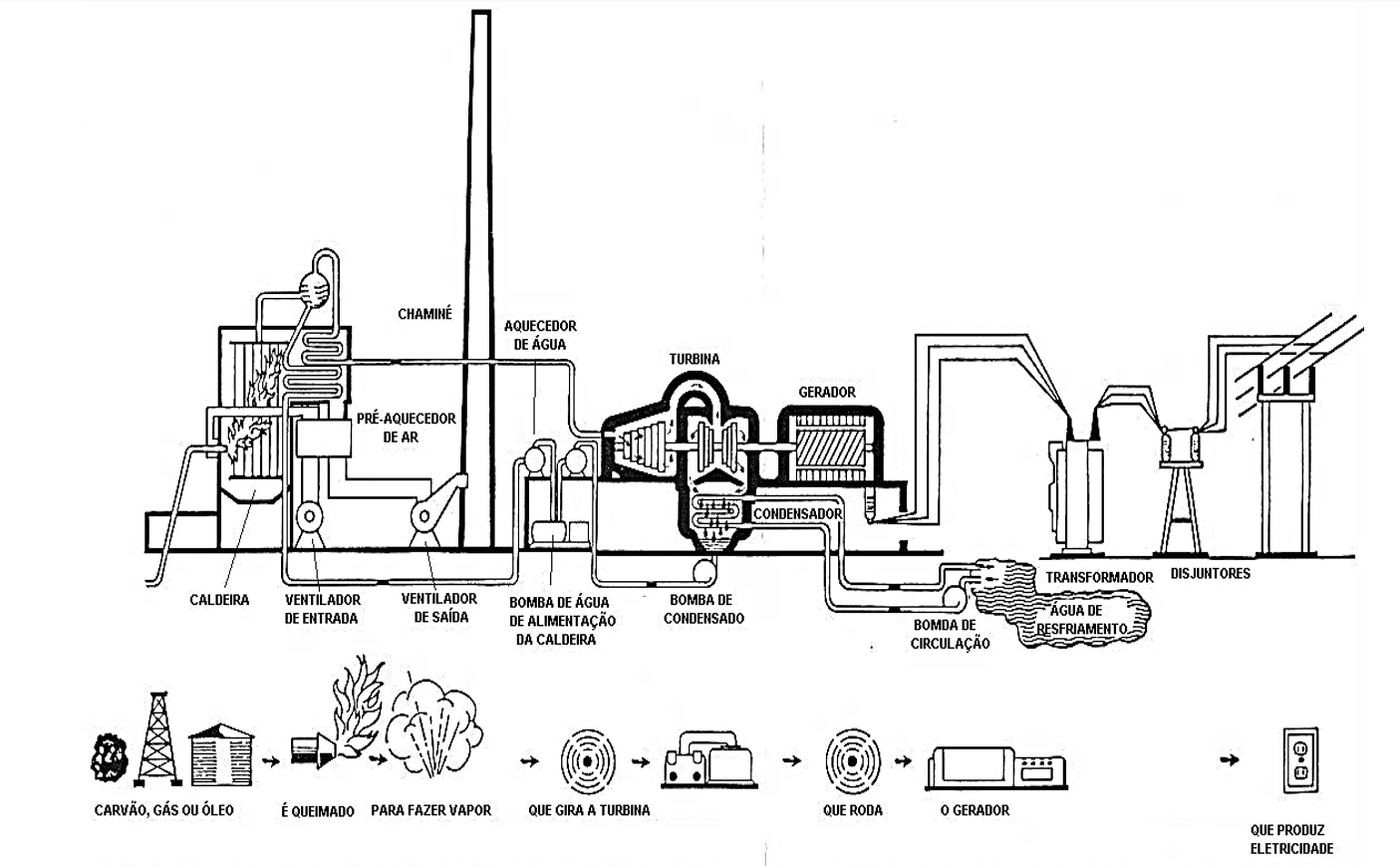
Source: www.alterima.com.br/
According to Pegollo (2006), in the nuclear plants is used the uranium composed by the U-235 (isotope with 92 protons and 143 neutrons) as fuel, due to its property of fission when reached by low energy neutrons. The process of generating energy consists of nuclear fission, that is, in the breaking of uranium within a nuclear reactor, producing a large amount of heat, which will serve to heat the water in a boiler and turn it into steam, from there the method for generating Energy resembles those of conventional thermal plants, the difference is in the fuel used.
We can also highlight the wind power plants, which uses the alternative source of wind power. Its operation consists in transforming the kinetic energy of the winds into mechanical energy when they are incised in the blades of the wind turbines that are coupled into generators, which in turn are used to convert the mechanical energy into electric energy. However, these plants are installed in regions with constant winds (PENTEADO and TORRES, 2010).
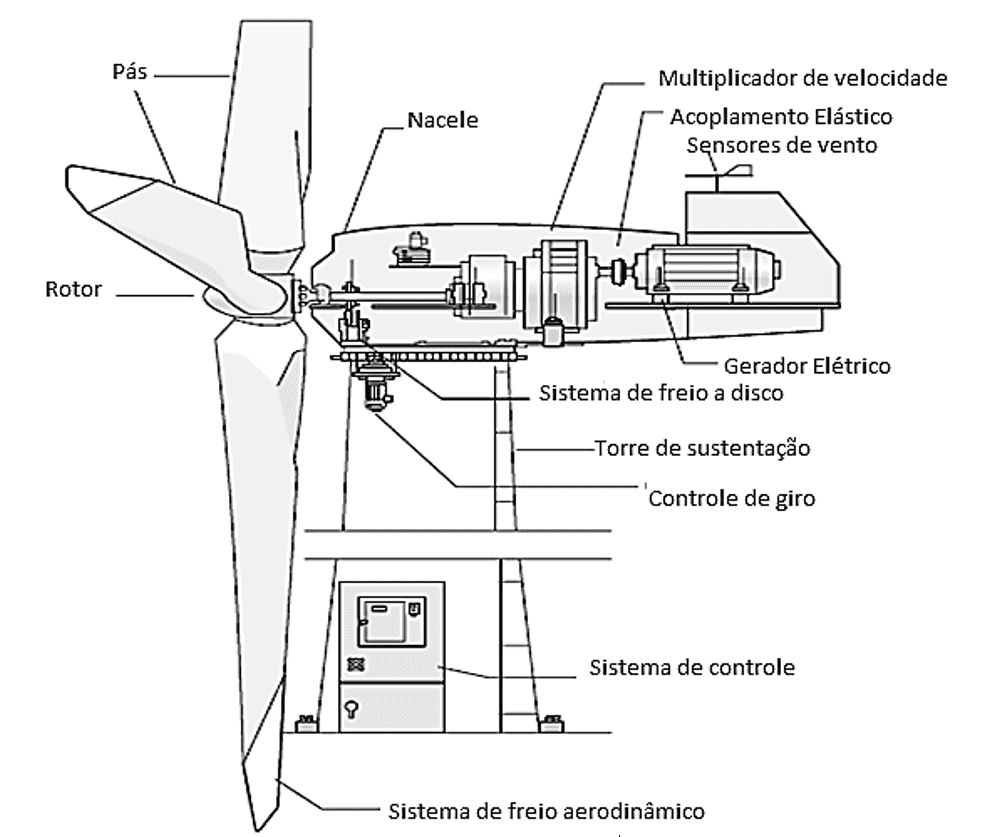
Source: www.alterima.com.br
It is important to clarify that all power plants are similar to the use of the generator to make the energy transformation, but the primary source that provides the energy for the rotation of the generator is what differentiates the types of Plants. In this context, it is important to highlight the principle of operation of this equipment.
5.2 OPERATION OF THE GENERATORS
The generators are devices capable of converting mechanical energy into electrical energy, they are composed basically by a rotor (magnet), which rotates inside a stator (coil), causing the appearance of an electric current. When a rotating movement is produced in the turns, through, for example, the movement of a turbine in the hydroelectric plants, there is a variation in the magnetic flux through the turn, causing an electrical current to emerge in the circuit due to the induced electromotive force That appears in this. This phenomenon known as electromagnetic induction obeys the laws of Faraday and Lenz (MUSSOI, 2006).
To understand Faraday’s law it is necessary to know the concept of magnetic flux, and to do this we will analyze the case of a surface area of a planar area inserted in a uniform magnetic field. In this case the surface is designated as normal, A and θ is the angle formed between the magnetic field and the normal surface, as shown in the figure below.
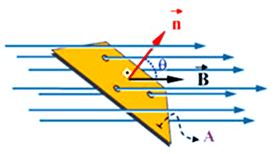
urce: Available at: www.brasilescola.com
Thus, we can define the magnetic flux represented by the letter Φ (FI), as the product between the magnetic field, the area of the flat surface and the cosine of the angle formed, i.e.:
Where the magnetic flux unit is defined by the international system of Units (SI), such as Weber (Wb). In this way we can perceive that the magnetic flux is related to the number of induction lines that traverse the surface, so we can conclude that the greater the number of lines that traverse the larger surface will be the value of the magnetic flux (LIGHT and ALVARES, 2000).
According to Penteado and Torres (2010), we can now enunciate the laws of Faraday, which points out that: whenever there is a variation of the magnetic flux through a circuit, an induced electromotive force (ε) appears in this circuit, which can be calculated by Equation:
Where![]() is the rate of variation of the magnetic flux, and N is the number of turns.
is the rate of variation of the magnetic flux, and N is the number of turns.
Having already discussed the situations in which an induced current appears in the circuit varying its meaning, we can emphasize the laws of Lenz that determines the sense of the current.
According to Luz and Alvares (2000), when Faraday studied the phenomenon of induction, he perceived the phenomenon of alternation of the induced current sense, but failed to elaborate a law that would allow defining such a phenomenon. This was only possible after the dissemination of Faraday’s work, with the studies of the Russian scientist Heinrich Lenz. He found that the sense of induced current appears so that it originates an induced magnetic field, which opposes the variation of the magnetic field inductor, notice in the figure below:
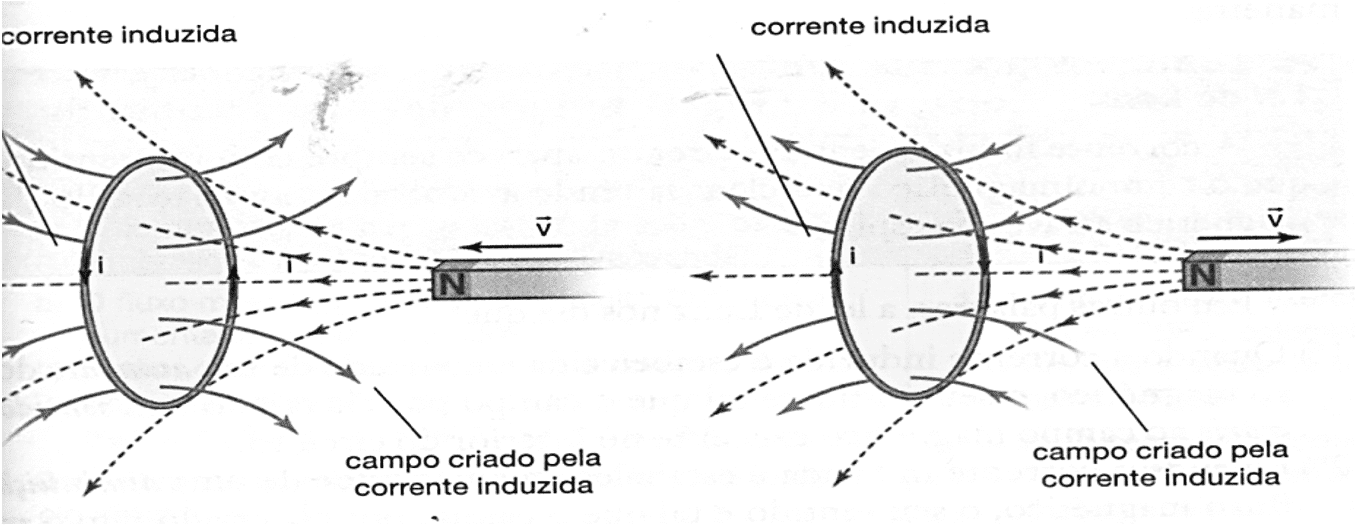
Source: LUZ E ALVARES, 2000, p. 299.
In this way we can interpret the law of Lenz as follows:
When the induced current is established by virtue of an increase in the magnetic flux, its meaning is such that the field created by it has felt contrary to the magnetic field inside the circuit. When the induced current is established by virtue of a decrease of the magnetic flux, its meaning and such that the field created by it has the same direction of the magnetic field inside the circuit (LUZ and ALVARES, 2000, p. 300).
It is important to note that in alternating current generators while the loop rotates ¼ back, its magnetic flux is increasing. But when it completes the ¼ the next, the magnetic flux is decreasing. It is for this reason that the induced current that arises in the circuit has its alternating direction. The generators in hydroelectric, thermoelectric, wind and nuclear power plants have a similar function to what has been described. However, it can be affirmed that in all power plants generators are indispensable.
5.3 2.4.3-THE ROLE OF SUBSTATIONS IN THE BRAZILIAN ELECTRICAL SYSTEM
After the whole process of generating the electric power it is necessary to drive it the elevating substations, because the alternating current generators that regularly generate a voltage of 13.8 KV cannot provide the high voltages required for transmission. This way in the substations it is possible to increase the voltages through the Transformers. It is important to remember that the Transformers are also used to lower the voltage in the lower substations near the consumption centers. Therefore, without these apparatuses, it would not be possible to transmit and distribute electrical energy in alternating current (LEÃO, 2009).
5.4 TRANSFORMERS
The first commercial model of a transformer was built by William Stanley around 1885, when he worked for entrepreneur George Westinghouse. His work was based on rudimentary projects of the Ganz company and the inventors Gaulard Lucien and Jonh Dixon Gibbs, being used for the first time in 1886 in the power system of the Great Barrington, Massachusetts by the company Westinghouse Electric Company has since undergone several modifications (size reduction, increased efficiency, capacity improvement) and has been used in the various branches of electronics (Edison Techcenter).
The ideal transformer is an electrical device that works with alternating electric current, effecting the modification of a supplied voltage. This apparatus consists basically of a nucleus made of ferromagnetic material, where are rolled electrolytic copper wires, forming two coils. As we can see in the following figure, the coil that is connected to the circuit that provides the voltage to be transformed is called primary winding, and the coil that receives the voltage already transformed is named secondary winding (TORRES, FERRARO and SOARES, 2010).
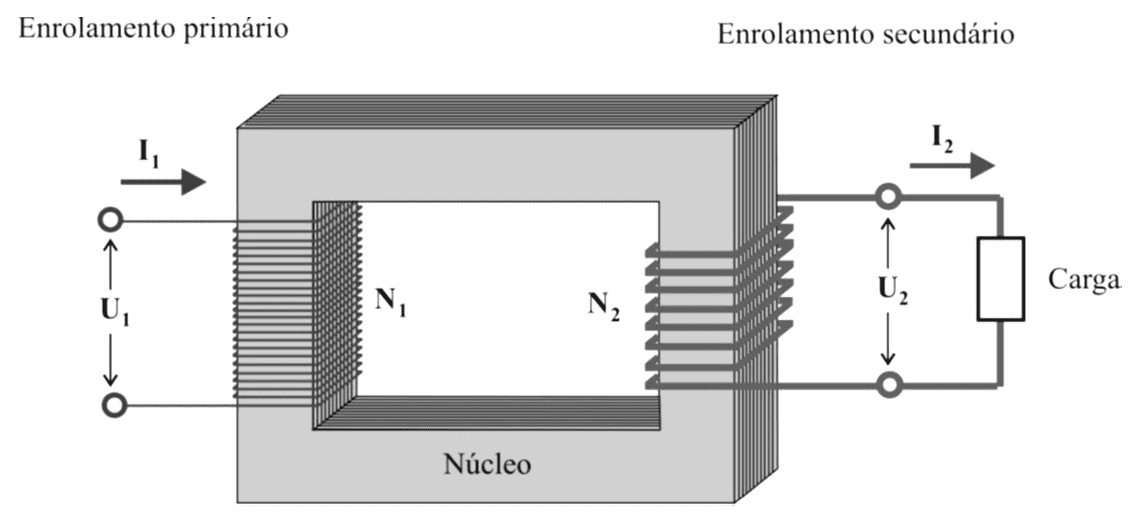
rce: NEVES and MUNCHOW, 2010, p. 79.
As for the operation of the transformer, according to Gaspar (2003) is based on the principle of electromagnetic induction. When a tension is applied to the primary winding, an alternating electric current goes through the turns of this winding, establishing in its interior a magnetic field that consequently imanta the iron core. Due to the voltage supplied be alternating the magnetic field established in the iron core, will be presenting consecutive oscillations, resulting in a variant magnetic flux through the secondary winding. In this way, we know that as the Faraday law mentions, a voltage induced in the secondary winding appears.
So, we can write from Faraday’s law, the relationship between the voltages in the primary and the secondary of an ideal transformer:
Where N2 is the number of turns on the secondary winding, and N1 is the number of turns on the primary winding. In this way we can demonstrate that if the number of turns on the secondary winding and higher than in the primary winding (N2 > N1) The transformer is used to raise the voltage, and in the reverse case (N2 < N1) The transformer will be lowering.
It is important to emphasize that it is not possible to change the voltage when using current continues, since it does not present a variant magnetic flux, so in these conditions the voltage in the secondary winding would be null. This being one of the factors that makes the use of alternating current in transmissions more feasible as described below.
5.5 THE PROCESS OF TRANSMISSION OF ELECTRICAL ENERGY
As already mentioned, electricity generation plants are generally distant from consumers, as they are installed in places conducive to the use of natural benefits, therefore, it is necessary to install networks of Power transmission, thus enabling the transport of energy from the points of generation to the distribution.
Transmission networks can be of type areas, underground or metallic trails. However, in Brazil, transmission is dominated by lines due to long distances. According to Leo (2009), these lines consist primarily of conductors, insulators, support structure and lightning bolts. Among the characteristics required for drivers, we can highlight the high electrical conductivity, reduced cost, low specific weight, appropriate mechanical strength and high resistance to corrosion and oxidation. Therefore, the materials usually used are aluminum and copper. With regard to insulators we can highlight that they play the role of suspending, fixing and separating, being subjected to both mechanical and electrical forces. In this way it is necessary that they provide great resistance to the passage of the leakage current surface, and that are reasonably consistent to prevent rupture under the voltage conditions that they must withstand. For this, insulators of the types are used: on disk, pin, suspension, and substation and line pillar insulators, these are constructed from glazed porcelain, tempered glass or rubber polymers, as these materials offer All the necessary characteristics to an insulator. The other components of the transmission lines are the structures and cables that contribute respectively in the support and protection of the lines.
According to Leite (2012), in the transmission of electric energy, the choice of alternating current was chosen, with voltages from 69 KV to 500 KV. Since 500 KV is necessary to study what type of current employed will be more economically viable to carry out such transmission. The main factor influencing the use of alternating current is the ease in raising or reducing the voltage, because during transmission will have the need to increase the voltage so that the losses by Joule effect are the smallest possible and reduce the Substations near the consumer centres.
5.6 THE IMPORTANCE OF DISTRIBUTION LINES
As we mentioned in the previous sub-chapters after the energy was generated and transmitted, it is distributed as efficiently as possible to consumers. Generally, the distribution networks operate at least with two voltages, a high voltage for large consumers such as industries and large commercial or residential buildings which in turn have a voltage reducing substation thus meeting the Feeding needs of your equipment. And a low voltage, intended for small users such as residences, in this type of distribution called secondary, the primary tension that in Brazil is 13.8 KV pass by transformers located in public poles, where the tension is lowered to the necessary level of supply of electrical appliances, i.e. for 127 or 220 V (BOLSONI, 2012).
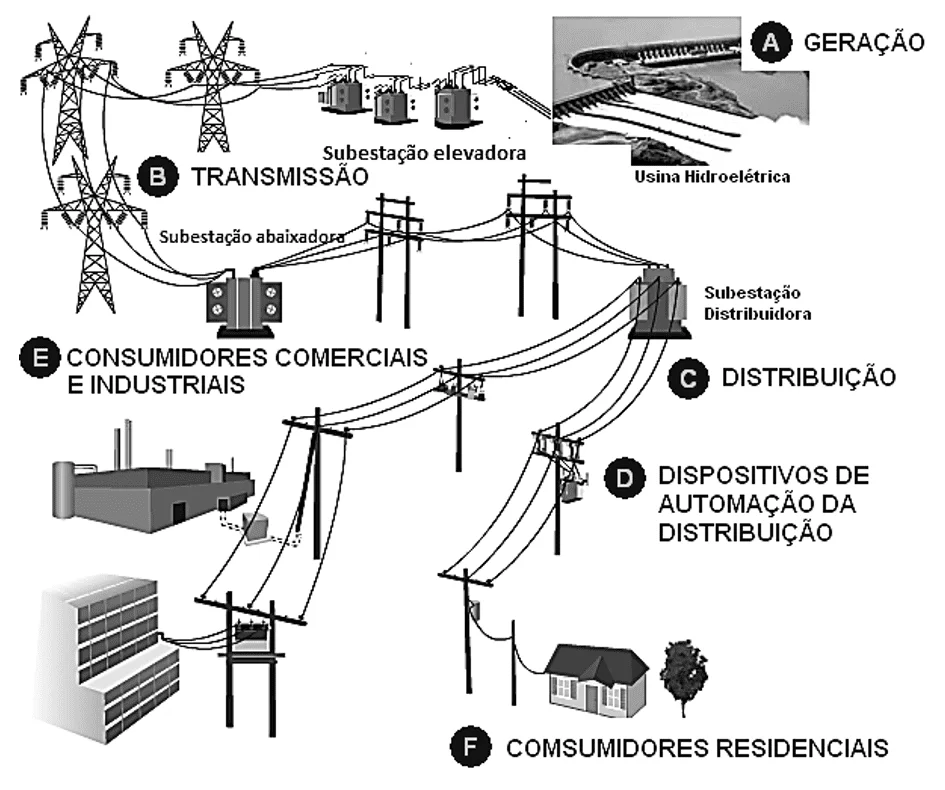
Source: Adapted from www.redeinteligente.com
5.7 2.4.6-THE ELECTRICITY CONSUMPTION IN THE CURRENT WORLD
Electricity has become fundamental for technological and scientific development in the current world, and consequently has become a priority in the daily life of the human being, we can express such evidence with the affirmation of Ferreira et al:
The electricity sector, increasingly, has been consolidating itself with one of the strategic areas for the development of the current society, due to the growing demand for technologies, which generally work on the basis of this input, and are indispensable to raise the Standard of living or well being, as well as the economic standard of society as a whole. It is easy to see that electricity is responsible for the operation of various services and equipment that make life more practical and comfortable (2010, p. 18).
However, the electricity that reaches the consumer is present in the form of a sine alternating current, with constant frequency, but there is a diversity of electronic devices that need to be fed with direct current, for example, the Computers, mobile phones, photographic camera, among others, thus arises the need for a current rectifier circuit, that is, a circuit that transforms alternating current into direct current.
Regarding the classification of the Rectifiers Pomilio (2012) states that they can be classified in controlled or uncontrolled, according to their ability to regulate the value of the output voltage; Monophasic, three-phase, etc. According to the number of phases of the alternating input voltage; Half wave or full wave, according to the type of connection of the rectifiers elements. When using equipment that requires for its high-power operation, it is necessary to use three-phase rectifiers, these in turn must be prepared in such a way that they avoid damaging the neighboring electrical equipment or networks. “Conventional three-phase power supplies use rectifiers to diode, or thyristors when you want some control of the power flow and the output voltage” (BARBI et al, 2002, p. 1). It is worth emphasizing that the process of rectification of the current will not be deepened, as this is not the objective of this work.
6. THE TEACHING AND LEARNING OF PHYSICS
Although physics is one of the areas, with concepts so present in our daily lives, it has been verified for a time that this discipline has not succeeded in schools to motivate students and they perceive it as difficult, abstract, besides not relating to the Day-to-day (SOUZA et al.,2009). According to Martins (2006), and Bonadiman (2004), this view is the result of traditional teaching used by schools, this being a model centered on formalism where there is no articulation between physical phenomena and the world in which the student is inserted, on Of that Bonadiman et al. Express the consequences of such a teaching method.
In view of this teaching model, students little or nothing learn from physics. What they often learn is not to like it, carrying that aversion with you for the rest of your life. For many people, speaking in physics means to warn unpleasant memories, being even very common to hear expressions like this: “Physics is a thing for crazy!” (BONADIMAN et al., 2004, p. 2).
Therefore, proposals have been expressed that lead to the development of an education directed to the full formation of individuals, thus Lopes, Martins and Rios affirm that these “must be able to understand the current technological advances and the Act in a reasoned, conscious and accountable way in view of their possibilities and interference in the social groups in which they live “(2011, p. 2). Thus, these proposals are consistent with the guidelines of the national curricular parameters for high School (NPC), which aims to construct a vision of physics focused on the formation of a contemporary reflective and active citizen suggests the directions About Physics Teaching:
Physics should be presented, therefore, as a set of specific competencies that allow us to perceive and deal with the natural and technological phenomena, present both in the immediate daily life and in the understanding of the universe that lead to possible Distant solutions, based on principles, laws and models built by it (BRASIL, 2002, p. 59).
However, it is necessary to adopt strategies that enable such proposals, thus overcoming the shortcomings pointed out earlier. In this context, it is worth highlighting the tool of experimentation, because according to several researchers it has been appointed as a teaching strategy in order to provide motivating activities where there is the interaction of the student with materials, leading him to reflect, Questioning, handling, observing and understanding the phenomena involved, thus providing a meaningful and consistent teaching and learning (LOPES, MARTINS and RIOS, 2011; ARAÚJO and ABIB, 2003; SILVA, 2010). It is important to clarify that experimentation should not be approached only as a motivator in teaching learning, as it approaches Oliveira et al. (2010) More than attracting attention should be used the sensation of novelty provided by an experimental activity to construct a knowledge closer to the student.
Justly to experimentation, we emphasize the importance of the historical approach of science in the teaching and learning process, because this strategy allows the student to mature about their conceptions about the nature of science, its development, Its limitations, its relations with other domains in order to promote the debate of ideas, thus contributing to the building of a critical individual in the current society (HYGINO, SOUZA and LINHARES, 2012). Complemando, we can cite the opinion of Martins (2006) about this approach in the teaching of physics:
The proper study of some historical episodes allows understanding the interrelations between science, technology and society, showing that science is not an isolated thing of all others, but is part of a historical development, a culture of a Human world suffering influences and in turn influencing many aspects of society (2006, p. 1).
He perceives in the cited literatures that there are many barriers for such a strategy to definitely play a key role in teaching, but for some years the educators have perceived the importance of the emphasis of the process of building science along the History of mankind, to complement other approaches in teaching, in such a way that such proposals have been reflected in the national curricular parameters for high school.
Based on what we discussed throughout the theoretical framework we propose the elaboration of a didactic material about electricity, addressing its process from generation to distribution, so as to enable us to combine the approach of the history of science to experimentation, Allowing the understanding of the physical phenomena involved to decrease the distance between technology and user.
7. MATERIALS AND METHODS
To elaborate this work, we initially conducted bibliographical researches referring to historical development from the beginnings of electricity to its practical application on a commercial scale, highlighting the characters involved in Knowledge construction process. Continuing the work, it was effective to deepen the theme regarding the use of experimentation, allied to the historical study of science, as a didactic-pedagogical proposal in the improvement of the teaching and learning of physics, highlighting its points Positive and its limitations.
After this process of deepening, a proposal of didactic material was elaborated for the teaching of electricity, since the generation in the large plants the distribution, for this was built in the physics laboratory of the IFNMG-Campus Januária, a model, Demonstrating the processes of which the electrical system is constituted, having as the source of energy primary to the force of the winds. To manufacture such an experiment was used low cost materials and scrap as: wood, paper, paints, laminated wires, LEDs, transformer, generator, foam and plastic propeller.
After the construction of the experiment, we elaborated a proposal of an experimental script that is found in the appendix of this work, being directed to an open approach, allowing the analysis, observation, handling, reflection of the phenomena involved, thus promoting the debate of ideas. It is also suggested the investigation of the evolutionary process of the use of electricity for commercial purposes, highlighting the factors that influenced this course, for example, the development of the equipment necessary for the execution of such activity and the Discoveries of scholars in this matter that have contributed to the improvement of existing projects. This theme can be explored through research in books, magazines, Web pages, and etc., being at the discretion of the teacher user to make possible changes.
8. RESULTS AND DISCUSSION
Based on the bibliographical research on the process of knowledge development over the years, starting the studies from the first observations of electrical phenomena its practical application with the implantation of the electrical power system Predominant in the current society, it was verified the importance of the contribution of each discovery reached by the scholars of the time in the process of constructing science, generating even a more realistic conception about these characters in this context of Constant change, favoring the understanding of science as a socially and historically situated study.
We can also see the effective collaboration of experimentation in the learning process, however so that students can develop an active role in the construction of knowledge, it is necessary to use an appropriate teaching methodology. To do this when using an experiment, the teacher must go beyond the transmission of knowledge, allowing the expansion of the horizons by the students, making them not only limited to observation. It is necessary in this context to reflect, research, the articulation between the theoretical concepts and the daily life of the student, thus providing a debate of ideas, which will contribute to the formation of a more conscious, updated, interactive, thus establishing a new vision of physics.
9. FINAL CONSIDERATIONS
In this work we seek to understand the process of historical development of electricity and identify how the use of electricity in existing technologies can help the student in understanding the contents. For this we seek from the bibliographic research, investigate the contributions given by the scholars of this theme and the consequent changes in the world scenario resulting from the evolution of knowledge. In addition, we sought to analyze the importance of experimentation and the historical study of science, as a teaching strategy, to effectively understand the contents studied in the classroom. Finally, we make the production of a teaching material, addressing the processes involved in the current electrical system.
Through what has been researched and analyzed, it is perceived that the practical application of electricity can help the student to understand the concepts involved in the study of electrical phenomena, provided that this theme has an appropriate approach both to the phase of Development and the reality of the learner. Thus, it can be verified that experimentation is indicated as an efficient teaching strategy, when it opportunizes debate of ideas, formulation, testing hypotheses and situations of investigation, thus enabling to know how to process the Construction of physical knowledge.
We can also infer that the inadequacy in the sequence of contents passes a deformed view of physics, thus hindering the comprehension of its concepts, thus the main activity of students of physics is the memorization of symbols, formulas, theories and Rules. However, when using the historical approach of science, emphasizing the origins of concepts and their development process, it creates a situation that is more likely to allow the student to contextualize the concepts studied, thus approaching the Scientific knowledge to the student’s cognitive universe, collaborating in the disruption of persistent dogmatic teaching.
Finally, based on the teaching strategies studied, we propose a material on the processes from the generation to the consumption of electricity, through the proper use of this, can promote the debate, research, motivation, research, maturation and Reflection of the student about his conceptions of the nature of science, and the use of natural resources, also contributing in the social formation of the citizen, finally can relate the physical knowledge to daily life, also breaking the dogmatization of science.
BIBLIOGRAPHICAL REFERENCES
Teslasociety, AC Motor-One of the Ten Greatest Discoveries of All Time. Available in <http: www.teslasociety.com=””>access on October 3.</http:> 2012, 09:12:34.
ALVES, Izalmárcio Rocha. The Schroedinger equation. 2008, 54 f. (Completion of course work). Degree in physics – State University of Mato Grosso do Sul, Mato Grosso do Sul, 2008.
ALVES, Mario Ferreira. ABC of electrical machines. Department of Electrotechnical Engineering-Instituto Superior de Engenharia do Porto. Available in: <http: ave.dee.isep.ipp.pt/~mjf/pubdid/abc_me.pdf=””>, Access on 10 Jun.</http:> 2012.
ARAÚJO, Mauro Sérgio Teixeira de; Maria ABIB, Lúcia Vital dos Santos. Experimental activities in physics teaching: different approaches, different purposes. Revista Brasileira de Ensino de Física, v. 25, nº 2, p. 176-194, 2003.
ASSIS, Andre Koch Torres. The experimental and historical foundations of electricity. Montreal, Quebec: Apeiron, 2010.
BARBI, Ivo; NOVAES, Yales Rômulo de; SOUZA, Fabiana Pöttker de; BORGONOV, Deivis. Unidirectional three phase PWM rectifiers with high power factor. Journal of the Brazilian Society of Power Electronics, v. 7, n. 1, p. 1-14, 2002.
BARBOSA, Paulo Henrique Ribeiro; BARBOSA FILHO, Francisco Ferreira. Physics III. Teresina: CEAD/UFPI, 2010.
BEISER, Arthur. Concepts of modern physics. São Paulo, S.P.: Polígono, 1969.
BEN-DOV, Yoav. Invitation to physics. Rio de Janeiro, R.J.: Jorge Zahar, 1996.
BOLSONI, Reinaldo C. R. Eletrotécnica Básica. Available in <http: www.ebah.com.br/content//eletrotecnica-basica-reinaldo-bolsoni=””>access on Nov 01.</http:> 2012, 07:55:09.
BONADIMAN, Hélio; AXT, Rolando; BLUMKE, Roseli Adriana; VINCENSI, Giseli. Diffusion and popularization of science. A physics experiment that worked. In: XVI National Symposium on Physics Education, p. 1-4. 2004.
BONJORNO, José Roberto et al. Fundamental physics. Single Volume, São Paulo, S.P.: FTD, 1999.
Brazil. National Energy Balance 2012 – Base year 2011. Rio de Janeiro, R.J. EPE, 2012.
Brazil. PCN + High School: Educational guidelines complementary to the national curricular parameters. Nature Sciences, mathematics and its technologies. Secretariat of Middle and technological education-Brasilia: MEC; SEMTEC, 2002.
CHAGAS, Aécio Pereira. The 200 years of the electric cell. New chemistry. V. 23, n 3, p. 427-429, 2000.
CH’I, John Paul M.C.; ASSIS, André K. T. Ampere and the origin of Earth magnetism. In: I Symposium on Research in Teaching and history of Earth sciences. III National Symposium on the Teaching of geology in Brazil. 2009, p. 315-320.
Alterima, hydro power plant components. Available in <http: www.alterima.com.br=””>Access on Oct 12.</http:> 2012, 21:23:12.
CORREA, Fernanda das Graças. Thomas Edison and the electrical lighting-a history of invention, science and technology. Electronic magazine Brazilian defense strategy-the policy and the armed forces in debate, N. 19, Rio, 2011. Available at http://www.reebd.org/2011//thomas-edison-e-iluminacao-eletrica-uma.html > access on June 15th. 2012.
DIAS, Valéria Silva; MARTINS, Roberto de Andrade. Michael Faraday: The path of the bookstore to the discovery of electromagnetic induction. Science & Education Magazine, V. 10, n. 3, p. 517-530, 2004.
EISBERG, Robert; RESNICK, Robert. Quantum physics. -Atoms, molecules, solids, cores and particles. 34ª reimpr. Rio de Janeiro, R. J.: Editora Campus, 1979.
San Francisco Portal, hydroelectric power. Available at http://www.portalsaofrancisco.com.br/…hidreletrica/energia-hidreletrica.ph: Access on 02 10. 2012, 12:33:21.
FERREIRA, M.S.; CAVALCANTE, C. A.; FONTES C. H., S. Marambio, J. E. The Brazilian electric sector. Magazine of the Polytechnic Institute of Bahia. Nº 7-E, p. 18-25. 2010.
Brazil school, magnetic flux and Faraday’s law. Available in <http: www.brasilescola.com=”” › física › eletromagnetismo=””>Access 02 out.</http:> 2012, 23:22:12.
FUKE, Luiz Felipe; KAZUHITO, Yamamoto. Physics for high School. V. 3, São Paulo, SP.: 2010.
GASPAR, Alberto. Physical. V. 3. São Paulo, S. P., Editora Ática, 2003.
GERMANO, Marcelo Gomes; LIMA, Isabelle Priscila Carneiro de; SILVA, Ana Paula Bispo da. Voltaic cell: Between frogs, mates and needs. Brazilian physics teaching Notebook, V. 29, n. 1: p. 145-155, 2012.
GONÇALVES FILHO, Aurélio; TOSCANO, Carlos. Physics and reality. V. 3, São Paulo, S.P. Spcione, 1997.
GUERRA, Andreia; REIS, José Claudio; BRAGA, Marco. A historical-philosophical approach to electromagnetism in high school. Brazilian physics teaching Notebook, V. 21, n.2, p. 224-248, 2004.
HARF, Rainer. The Wizard of electricity. Geo Magazine, Edition10, 2010.
HYGINO, Cassiana Barreto; SOUZA, Nilcimar dos Santos, LINHARES, Marília Paixão. Reflections on the Nature of Science in physics classes: Study of a History of Colonial Brazil. Revista experiences in science teaching, V. 7, n. 2, p. 14-24, 2012.
LAMARÃO, Sérgio Tadeu de Niemeyer. The electric power and the Carioca Industrial Park (1880-1920). In: Simposio Internacional globalización, innovación y centros estética de redes urban techniques en América y Europa, 1890-1930. P.1-28, 2012.
LEÃO, Ruth. GTD-generation, transmission and distribution of electric power. Didactic notebook of the Federal University of Ceará-Department of Electrical Engineering. Available in: <http: pt.scribd.com/doc/54810993/apostila-gtd-i-v1=””>access on 20 of AG.</http:> 2012, 12:15:18.
LEITE, Carlos A. F. Instalações Elétricas. Didactic notebook of UNESP available in <http: unilins.edu.br.pdf=””>access on 21 Sep.</http:> 2012, 08:03:55.
LOPES, Paulo César de Castro; MARTINS, Marcos Gomes; RIOS, Lilian Rodrigues. Experimentation in the teaching of physics as a possibility of reflection in the initial formation of teachers. In: IV EDIPE – ENCONTRO ESTADUAL DE DIDÁTICA E PRÁTICA DE ENSINO. P.1-6 ,2011.
LUZ, Antônio Máximo Ribeiro da; ALVARES, Beatriz Alvarenga. Physical. V. 3, São Paulo, S.P. Spcione, 2011.
MACHADO, Kleber Daum. Electromagnetism theory. V.1. Ponta Grossa. UEPG. 2000.
MAGNAGHI, C. P; ASSIS, A. K. T. About electricity excited by simple contact between conductive substances of different types-a commented translation of the article back from 1800 describing its invention of the electric cell. Brazilian physics teaching Notebook. V. 25, n. 1: p. 118-140, 2008.
MARTINS, Roberto de Andrade. The history and its uses in education. In: Studies of History and philosophy of Sciences: Subsidies for application in teaching. SILVA, Cibelle Celestino (Org.). São Paulo, S.P.: Livraria da Física, 2006, p. 7-30.
MARTINS, Roberto de Andrade. Alessandro Volta and the invention of the pile: difficulties in establishing the identity between galvanism and electricity. Revista Acta Scientiarum Technology, v. 21, n. 4, p.823-835, 1999.
MARTINS, Roberto de Andrade. The context of the invention and dissemination of the electric pile by Alessandro Volta. Pp. 285-290. In: Annals of the VII National seminar on the History of Science and technology and the VII meeting of the network of exchanges for history and epistemology of chemical and biological sciences. São Paulo: Brazilian Society of History of Science/EDUSP, 2000.
MOTA, Rosana Paiva. Optimum operation model for Rio Pardo waterfall. 2010, 82 f. (Completion of course work – electrical engineering). Federal University of Rio de Janeiro, 2010.
MUSSOI, Fernando Luiz Rosa. Senoidal signals: Alternating current and voltage. 3ª ed. Florianópolis, S. C., CEFET, 2006.
NEVES, Eurico G. de Castro; MÜNCHOW, Rubi. Electrotechnics. V. 1. Didactic notebook of the Universidade Federal de Pelotas-Engineering Center. 2010. Available from: http://www.minerva.ufpel.edu.br/~egcneves/biblioteca/biblioteca.html > access on Jun 19. de 2012, 19:23:09.
OLIVEIRA, Márcio Marques Lopes de; COSTA, Rita de Cássia da; SOTELO, Daniela Govoni; ROCHA FILHO, João Bernardes da. Experimental physics practices in the context of teaching by research: a reflection. Revista experiences in science Teaching, v. 5, N. 3, p. 29-38, 2010.
PEGOLLO, Carlos Alberto Göebel. The use of nuclear energy in the generation of electricity. Integration Magazine, year XII, N. 47, pag. 357-362, 2006.
PENTEADO, Paulo César M.; TORRES, Carlos Magno A. Physics: Science and technology. V3, São Paulo, S.P.: Modern, 2010.
POMILIO, José Antenor. Non-controlled rectifiers and power factor. Available at:<http: www.dsce.fee.unicamp.br/~antenor/pdffiles/ee833/modulo1.pdf=””>, accessed on: Nov 22.</http:> 2012, 08:40:30.
POMILIO, José Antenor. A brief history of industrial electricity and power electronics, 2012. Didactic notebook of the State University of Campinas-Department of Systems and Energy control. Available in <http: www.dsce.fee.unicamp.br/~antenor/pdffiles/ee833/hist.pdf=””>access on 10 Jun.</http:> 2012.
QUIMARÃES, Hanny. Chain wars. Revista Eletric Collection-the stories and characters of the world of electrical installations, v. 4, 2008.
Smart Grid. Because, like, who, when, where? Available in <http: www.redeinteligente.com.=””>access on Oct 29.</http:> 2012, 09:23:44.
ROCHA, José Fernando M. et al. (Org.). Origins and evolution of the ideas of physics. Salvador: EDUFBA, 2011.
SILVA, Cibelle Celestino; PIMENTEL, Ana Carolina. An analysis of the history of electricity present in textbooks: The case of Benjamin Franklin. Brazilian physics teaching Notebook, V. 25, n. 1: p.141-159, 2008.
SILVA, Luciano Fernandes; CARVALHO, Luiz Marcelo de. The environmental theme and the teaching of physics in the middle school: some possibilities to develop the theme of large scale electric energy production in a teaching situation. Brazilian Journal of Physics Education, V. 24, n. 3, p. 342-352, 2002.
SILVA, Mauricio Nogueira Maciel da. The current role of experimentation in physics teaching. In: XI Salão de Iniciação Cientifica – PUCRS. 2010, p. 902-905.
SOUZA, Antônio Lopes de; MARTINS, Margareth Guimarães; QUAGLINO, Maria Ana; HAZAN, Sergio Sami. Gramme and the development of their machines: a multimedia experience. In: XIV Regional Meeting of the ANPUH-Ri. P. 1-11, 2010.
SOUZA, Marcus Venícius Juliano de; DANTAS, Valter Assis; FREITAS FILHO, J. Rufino de; ALMEIDA, Maria Angela Vasconcelos de. Use of a study situation as a form of alternative for the teaching of physics. Revista Ensaio, vol. 11, nº 1, p. 1-15, 2009.
Edison Techcenter , The History of the Transformer. Available in <http: edisontechcenter.org/transformers.html=””>access on October 23.</http:> 2012, 23:22:12.
TOLENTINO, Mario. ROCHA-SON Romeo C. The bicentennial of the Electric cell. New chemistry at school, v. 1, N. 11, p. 35-39, 2000.
TORRES, Carlos Magno A.; FERRARO, Nicolau Gilberto; SOARES, Paulo Antonio de Toledo. Physics – Science and technology. 2nd ed. V. 3, São Paulo, S. P: Moderna, 2010.
WHITE, Michael. Productive rivalries: disputes and fights that have boosted science and technology. Translation: Aluízio Pestana da Costa. 2nd ed. Rio de Janeiro, R.J. Record, 2003.
WHITTAKER, E. A History of the theories of Aether and electrity. New York: Humanities Press, 1973.
Annex
EXPERIMENTAL ROADMAP
ELECTRICITY: FROM GENERATION TO DISTRIBUTION
THEORETICAL INTRODUCTION
Currently the electricity sector, is considered one of the areas of prominence in the labor market, due to the large demand of electricity in today’s society. It is important to emphasize that the electricity we have, thus enabling a more comfortable and pleasant life, is a form of secondary energy, that is, it is necessary a source of primary energy for its production, for example, coal, Oil, natural gas, uranium, sugarcane product, river waters, Wind, Sun, among others.
In Brazil the electric sector is constituted of the system of generation, transmission and distribution. The generation process is carried out in large mills, where primary sources are used to provide the energy possible to the generator’s rotation, and this transforms it into electrical energy. In this way the plants resemble the use of the generator and differentiate themselves by the primary source of energy used to move the generator, we have, for example, the use in hydroelectric power plants of water fall, in the thermoelectric water vapor, in Wind power. This indispensable equipment nowadays has its operation based on the laws discovered by physicist Michael Faraday: Electromagnetic induction, which consists in the emergence of an electrical current induced in a circuit due to the electromotive force Induced there, when there is a variation of the magnetic flux in that region. The current obtained through this generator varies periodically from intensity and direction, i.e. it is an alternating current.
Shortly after the generation, the electric power is sent to the elevating stations, where with the use of transformers are the increase of the voltage, thus decreasing the intensity of the current, because the generators existing in the mills are not able to provide The high voltages needed to transmit the energy from the generation point to the distribution points. It is opted for the transmission of electric power in alternating current due to the ease in raising or reducing the voltage, because during transmission will have the need to raise the voltage so that the losses by Joule effect are the smallest possible, as Reduce the tension in the substations near the consumer centres.
The ideal transformer is an electrical device that works with alternating electric current, effecting the modification of a supplied voltage. This apparatus consists basically of a nucleus made of ferromagnetic material, where are rolled electrolytic copper wires, forming two coils. The coil that is connected to the circuit that provides the voltage to be transformed is called primary winding, and the coil that receives the voltage already transformed is named secondary winding. Its operation is based on the principle of electromagnetic induction, as follows: When a tension is applied to the primary winding, an alternating electric current starts to go through the turns of this winding, establishing inside a field Magnetic that consequently imanta the iron core. Due to the voltage supplied be alternating the magnetic field established in the iron core, will be presenting consecutive oscillations, resulting in a variable magnetic flux through the secondary winding, thus showing a voltage induced in the Secondary winding.
So, we can write from Faraday’s law, the relationship between the voltages in the primary and the secondary of an ideal transformer:
Where N2 is the number of turns on the secondary winding, and N1 is the number of turns on the primary winding. In this way we can demonstrate that if the number of turns on the secondary winding and higher than in the primary winding (N2 > N1) The transformer is used to raise the voltage, and in the reverse case (N2<N1) o transformador estará abaixando a tensão. o=”” transformador=”” estará=”” abaixando=”” a=””></N1) o transformador estará abaixando a tensão.>
However, after the processes of generation, transmission and distribution, the electricity reaches the consumer presents itself in the form of sine alternating current, with constant frequency of 60 Hz in the case of Brazil, however there is a diversity of appliances Electronics that need to be fed with direct current, thus arises the need for a current rectifier circuit, that is, a circuit that transforms alternating current into direct current.
GOALS
- Analyze the experiment in order to identify its components and the function performed by them.
- Understand the phenomena involved in which the operation of existing equipment is based on the model.
- To know the processes of generation, transmission and distribution of electricity, thus contributing to minimize the distance between technology and user.
MATERIALS USED
For the construction of the model to be used in this experimental practice the following materials were used: a table of 100×106 cm, wooden toothpick (popsicé and barbecue), two transformers, paints in various colors, enameled copper wire, twenty three LEDs 2, 5V, paperboard, printer engine, propeller.
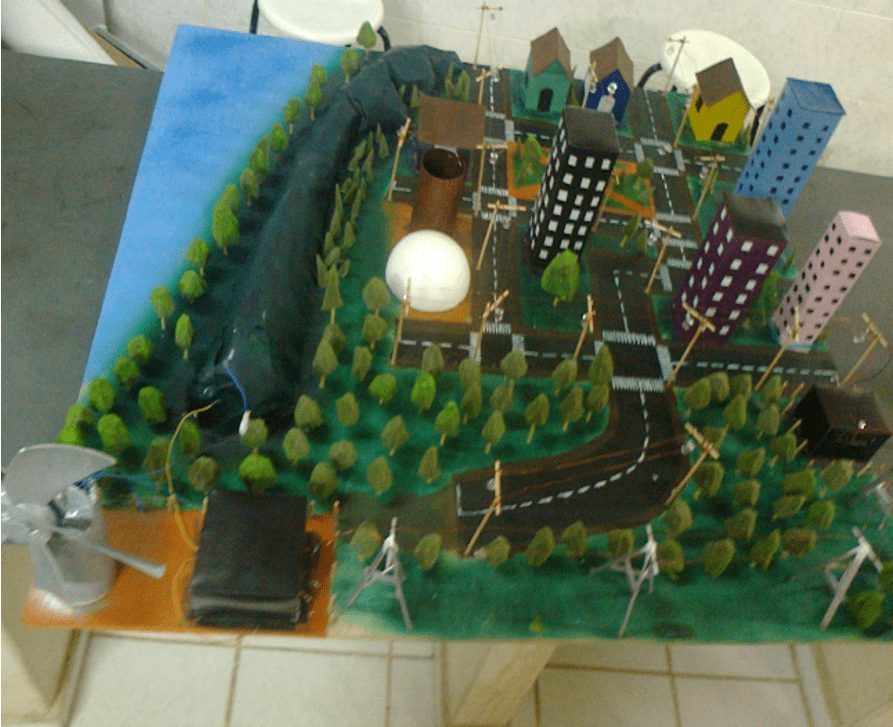
. Source: Personal file of the researcher.
ASSEMBLY PROCEDURES
For assembling the model was initially used spray paints to paint the river, forests, streets, mountain, houses and buildings. Next, the houses, buildings, square benches, trees, poles and the power generation system employing a propeller coupled to a generator were built and fixed on the table, and the terminals of the generator were connected to the transformer inlet. Located at the elevating station, thus effectifying the increase of the voltage provided by the generator.
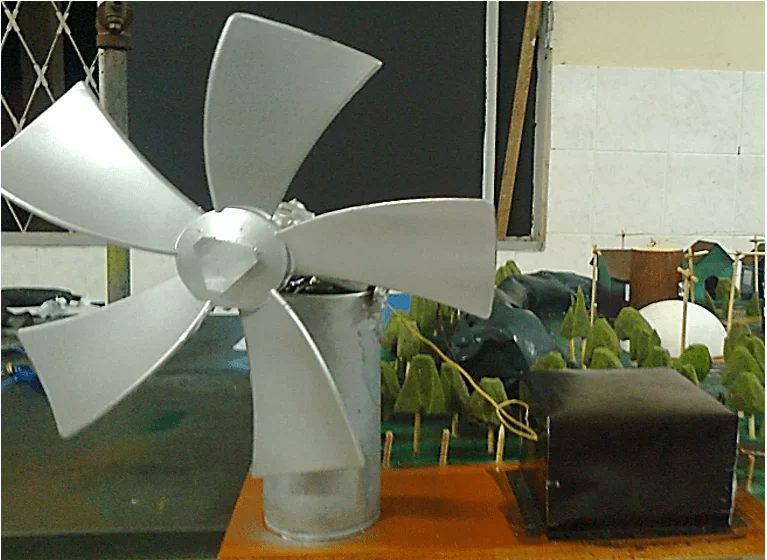
ource: Personal file of the researcher.
Subsequently, it was connected to the output terminals of the transformer enameled copper wire in order to carry out the power transmission system of the wind power plant to the lowering station near the consumer center, where by means of a transformer was Lowered the voltage.
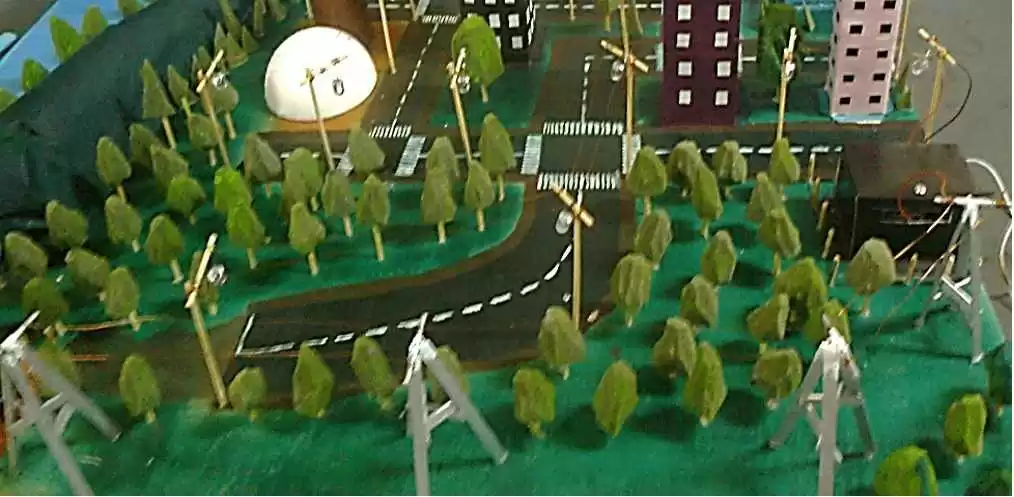
ource: Personal file of the researcher.
Thus, using the enameled wire, the connection was made to the terminals of the output of the transformer, then effecting the distribution of electricity to the consumers, where LEDs were used to represent the public lighting.
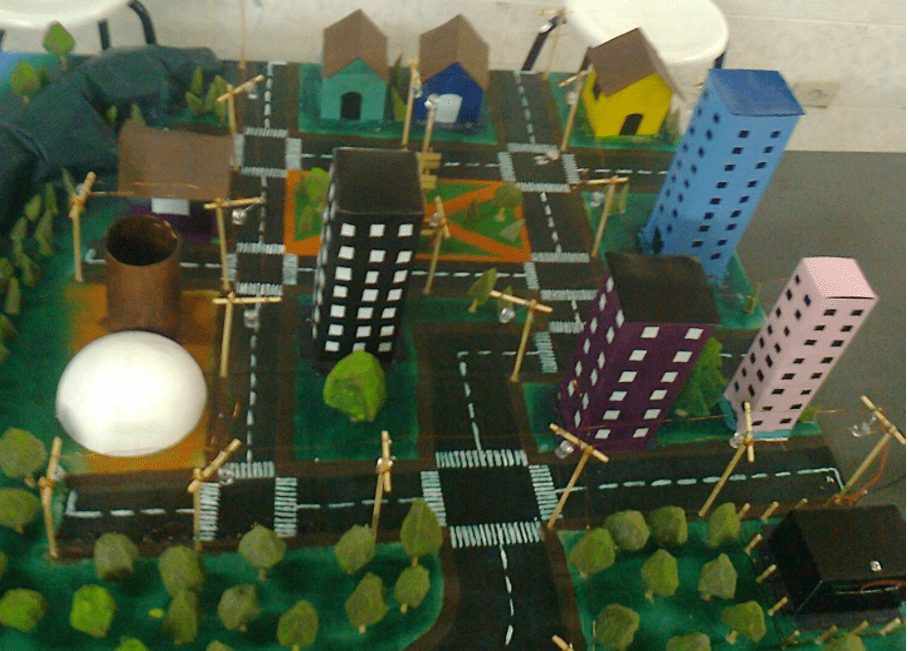
urce: Personal file of the researcher.
EXPERIMENTAL ROADMAP – PART I
In part I of this experimental practice will be performed the analysis of the model, in order to study its components, raising hypotheses about the role played by them.
- Identify the components of this model. Which procedure should be initially performed to perform its operation?
- In the wind mills what is the function of the generator? Discuss the operating principle of this equipment.
- Observing the model, we can verify the processes of which the Brazilian electrical system is constituted. Discuss the function performed by the transformer throughout these processes.
- Would it be possible to increase current voltage while still using a transformer? If we used the current continues in the transmission of electricity, would it be necessary to convert it to alternating current before distribution? Justify.
- Using a voltmeter measure the voltage that enters and exits the terminals of the voltage boost transformer. Immediately after measuring the voltage at the input and output terminals for the voltage lowering transformer. Comment on the results achieved? Are they consistent with the expected?
- Discuss the existing advantages of using wind energy in relation to other types of generation.
EXPERIMENTAL ROADMAP – PART II
In part two of this practice will be deepened the knowledge related to the historical development of the use of electricity for commercial purposes, through research in books, magazines, articles and on the Internet (sources with credibility) promoting So a classroom debate.
- After ten years since the first investigations on electromagnetism by physicist Michael Faraday, this comes to the elaboration in the year 1831 of the laws of electromagnetic induction. In this field of research that was performed the work of Faraday, this develops the first generator. However, this apparatus was not extracted any application that influenced at the time, but marked the beginning of new inventions resulting from studies on electromagnetism. Investigate and discuss in the classroom the contribution of the main scholars in the development process of the generators.
- It is known that Thomas Edison was the first to invest in the expansion and use of electricity for commercial purposes, implanting the first power plant that supplied current energy. Discuss the historical context in which these proposals were inserted.
- Through the studies of the Croatian Nikola Tesla, it became possible to generate and distribute electricity in alternating current, in order to overcome the limitations of its competitor. Search and discuss: what historical and social factors influenced Tesla’s discovery. As the process of inserting the electrical system into alternating current occurred over the years. What advantages presented in relation to current continues, favored the implementation of this system.
- It is known that the electric current that reaches the consumer is alternating, however there is a great diversity of appliances that only work when they are fed with continuous current, so it is necessary to use a rectifier. Search which types of appliances work with alternating current and which work with current continues.
- Nowadays we live surrounded by electrical and electronic appliances, which are indispensable for our well-being. However, we must be aware that we use a natural resource to produce the input required for the operation of these appliances. This theme lists the existing devices in their home and elaborating strategies that enable a more economical consumption.
[1] Graduated in physics, professor.
[2] PHD in Agricultural Engineering, master’s in applied physics, graduated in physics. Professor EBTT.
[3] Graduated in civil Engineering, quality engineering specialist, Professor EBTT.
Submitted: December, 2018.
Approved: March, 2019.
